The 2017 Ultra4 RCV Badlands Brawl had drivers climbing up rocks, navigating through the forest and of course, blasting through mud in Attica, Indiana. Although the course differed greatly from the MetalCloak Stampede's, the 4400 podium did not — with Levi Shirley and Wayland Campbell taking 1st and 2nd place once again. In typical Ultra4 Racing fashion, Badlands presented its share of firsts, misfortunes and surprising comebacks... Read all about it in our full race recap.
2017 Ultra4 RCV Badlands Brawl Recap [Gallery]
10 Rumors About the 2018 JL We Hope Are True
According to industry insiders, we’re just a few months away from the 2018 Jeep Wrangler JL unveil. Closing the chapter on the 2007 to 2017 Jeep Wrangler JK, the JL is one of the most anticipated Jeeps we can recall. With the Wrangler taking the No. 1 spot in the 2017 Cars.com "American-Made Index" list, the most historic American 4x4 has a lot riding on the new release. Maybe it’s the rumored new diesel engine or pickup truck variation, but there’s no doubt that the interwebs have been abuzz with talk of the JL over the past year.
With so much speculation, we’ve put together our list of 10 things we’re hoping to see and how the rumors support them.
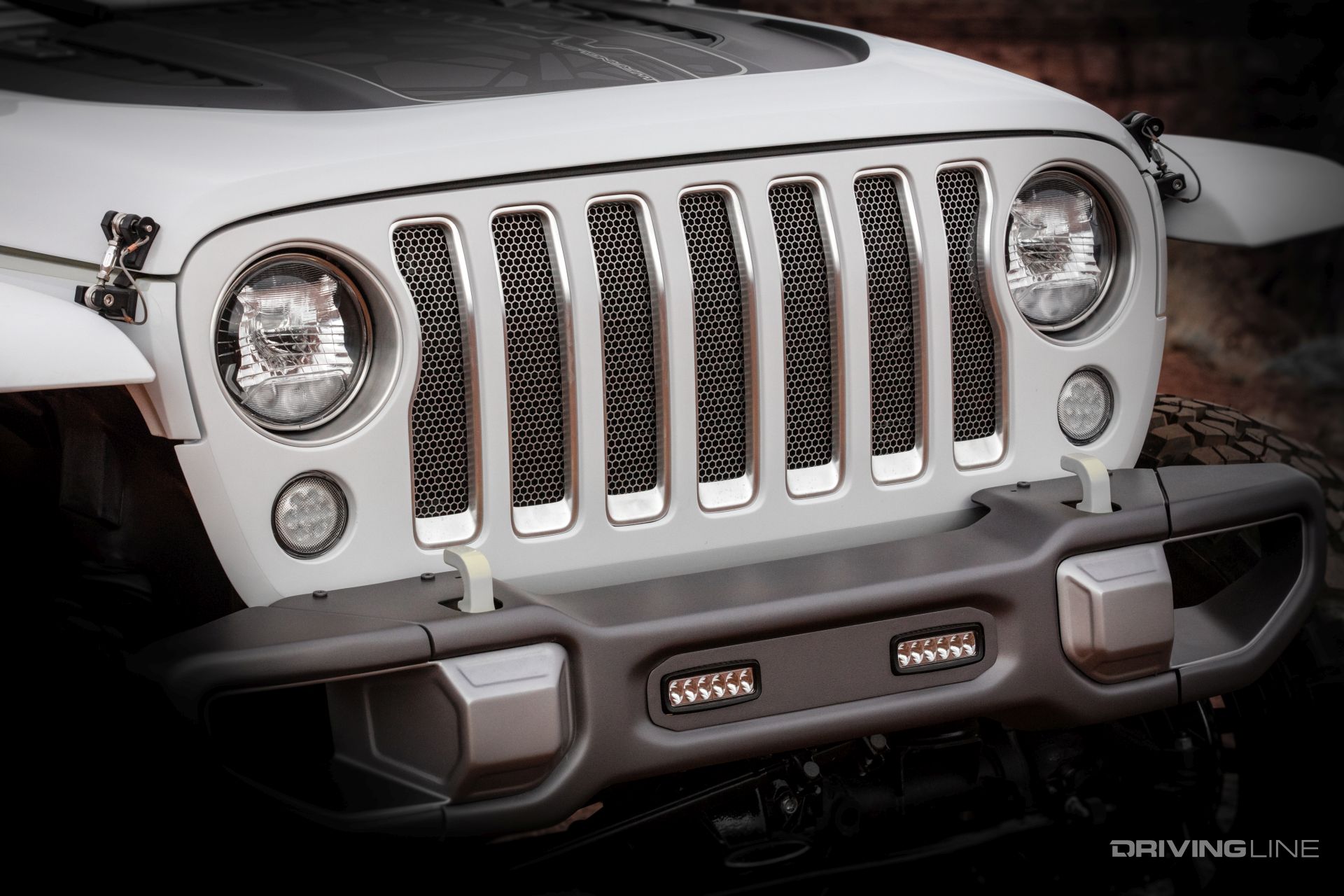
(All Photos Courtesy of Jeep)
1. Large Wheelwells
With so many spy shots circulating the web, it doesn’t appear the JL will deviate drastically from the outgoing JK. At least, the fender-wheel openings appear to be very similar. This likely means that like the JK, you’ll be able to stuff a large tire (35 to 37 inches) with a modest amount of lift.
2. Lighter Doors
The concept vehicles Jeep usually drags out to Moab, Utah, for the annual Easter Jeep Safari often hold clues to future products and designs. More than one concept at this year’s 51st Annual EJS had some sort of radical or lightweight door design. We’re hoping this means the JL’s doors will be lighter. This would make them easier to remove, while shedding some pounds from a Jeep that’s grown quite portly.
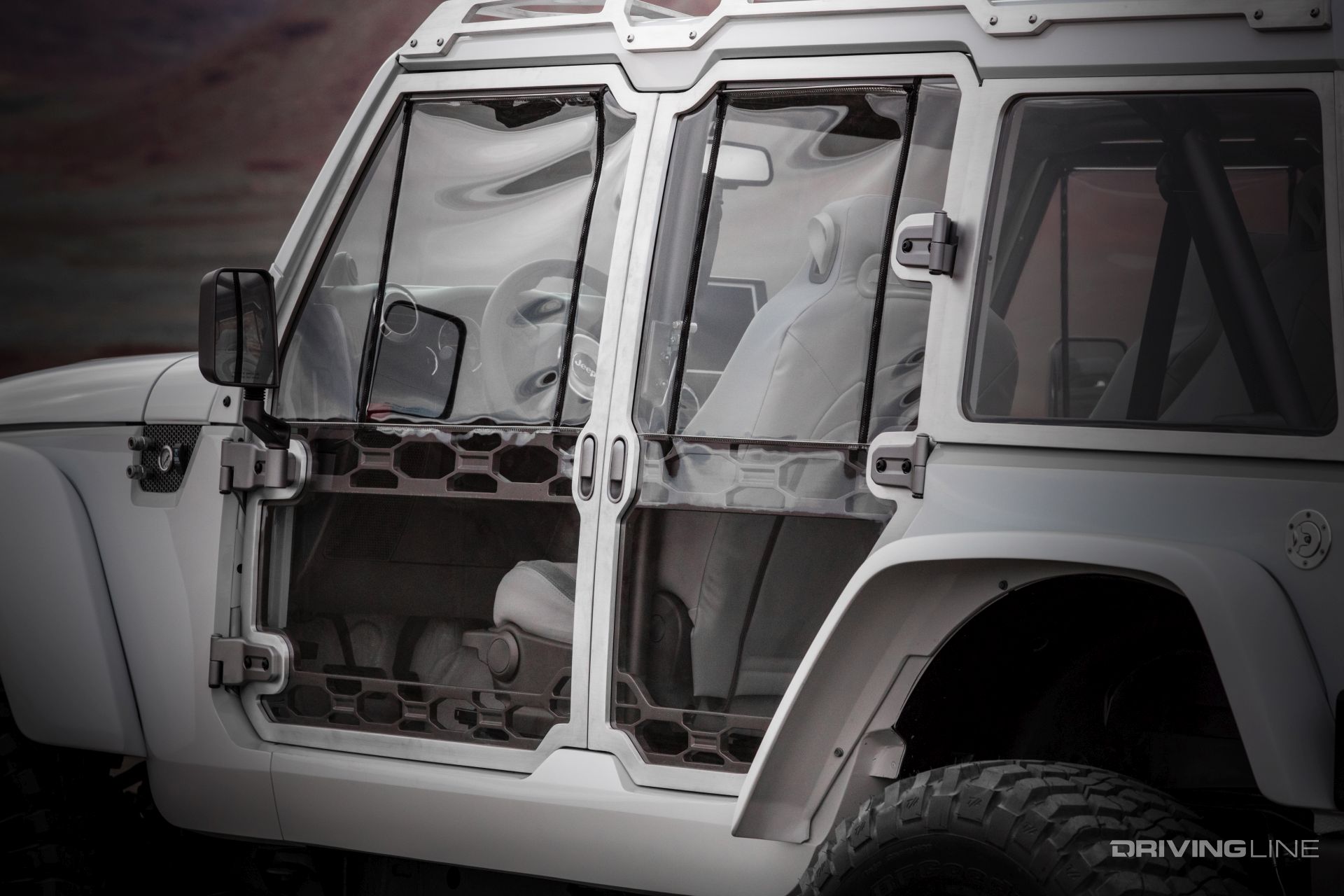
3. More Power!
We’re getting word that three new mills will be under the JL hood. A turbocharged four-cylinder, new V6 and a diesel. Rumor has it that the four-banger will pump out nearly 300 ponies, which would put it 15 horses over the JK’s current 3.6L Pentastar V6. If that’s the kind of juice the small engine can squeeze out, we’re hoping to see some big numbers from the V6. We expect the diesel will likely be high on torque, but modest on horsepower.

4. A Real Bed
The JL will continue the body-on-frame construction legacy along with retaining front and rear solid axles. Given that’s the case, it’s likely the JL truck variant will have a real bed, not just a unitized body like some sort of modern-day El Camino. This could be great for two important reasons: 1) It would open up the door for the aftermarket to create custom bed offerings, and 2) it could mean that multiple bed lengths are possible, making way for two- and four-door pickup platforms. We suspect the four-door version will be all we see at first.
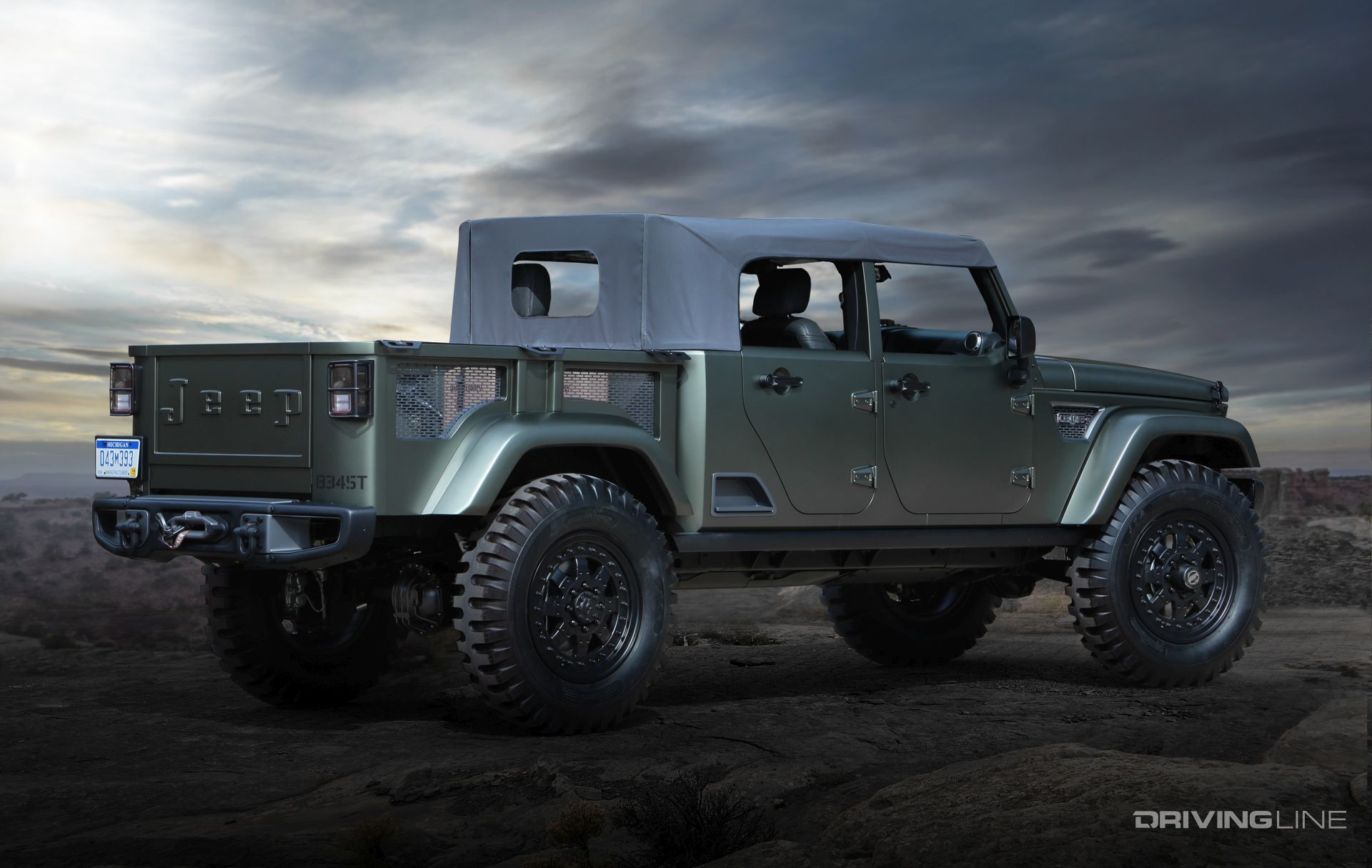
5. Electronic Nannies
Lane departure and crash avoidance sensors are heavily rumored to be part of the new Jeep. While the safety features will be a welcomed addition, it will likely prove challenging from a modification standpoint. We’re hoping that there will be some sort of electronic nannie override of defeat sequence. Something similar to what the Ford Raptor and Chevy ZR2 offers. This could be a game changer in the safety front, but may prove to be a serious hurtle for those looking to build their Jeeps to the extreme.
6. Better Axles
The JK axles are far better than the previous generation TJ axles, but they still leave plenty to be desired. Weak C end-forgings, thin-wall axletubing, and problematic ball joints are all well documented issues for the JK. We’re hearing that Dana has crafted an all-new JL axle set, which may not only fix the aforementioned JK axle problems, but increase the ring-and-pinion strength as well. While we don’t expect to see a 1-ton axle offering from the factory, we’re thinking the JL will see an axle upgrade.
7. Electronic Steering
Most auto manufacturers are shifting away from power-robbing engine-driven hydraulic steering pumps and moving to electric. Our inside sources are hinting that the new JL will have an electric steering pump as well. We’re also told this could be paired with an aluminum steering gearbox. For any hardcore off-roader, this may be a bit concerning. We’re guessing aftermarket steering manufacturers such as PSC Motorsports will be some of the first to come up with a steering upgrade.
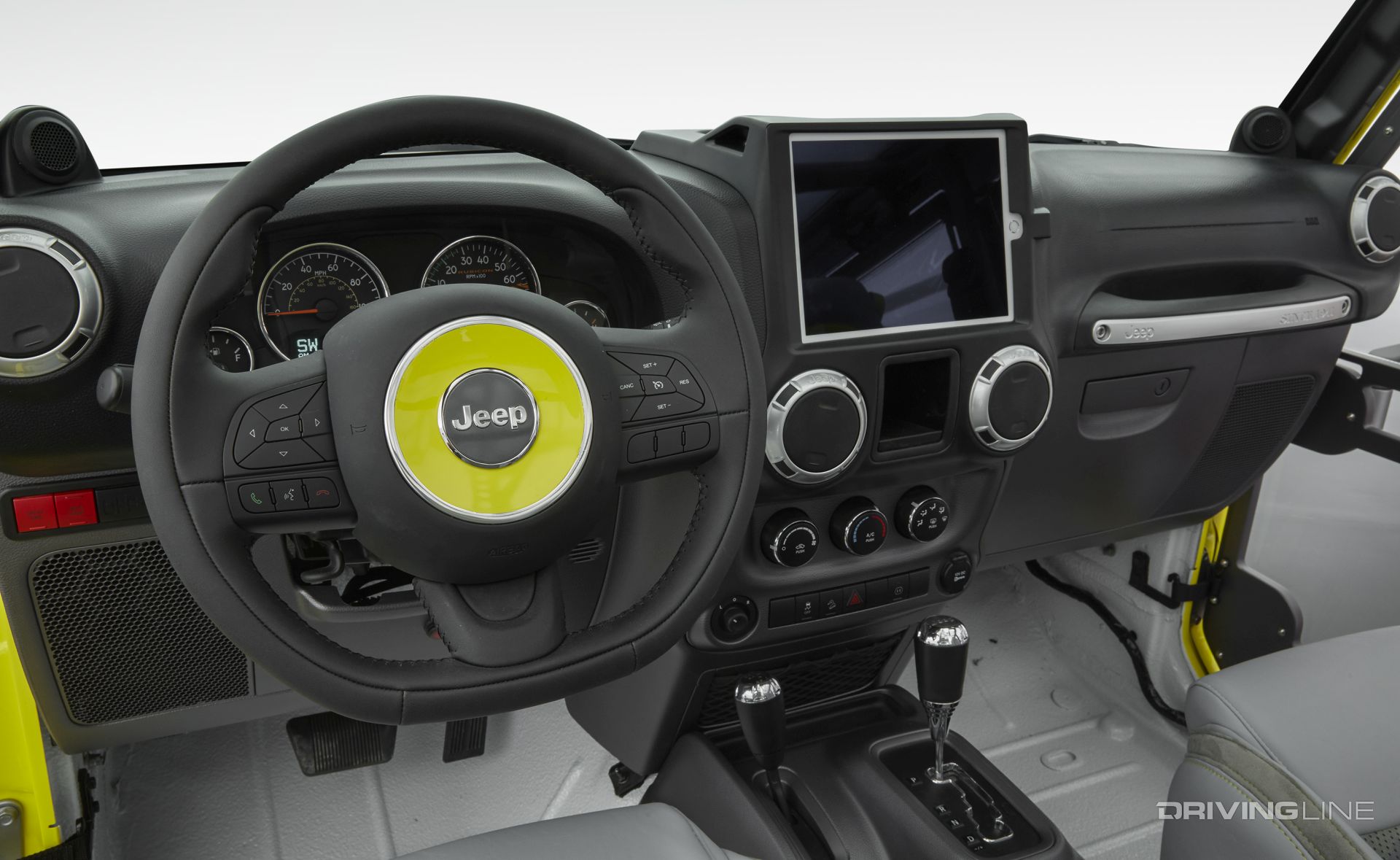
8. Give Us a Stripper!
Jeep has teased us with a stripper in the past. Get your mind out of the gutter. We’re not talking about that kind of stripper. We’re referring the J7 Stripper Jeep teased us with in 2010. It was a stripped-down version of the Wrangler Unlimited Rubicon. You got all of the good ‘wheeling parts you need (front and rear lockers, Dana 44 axles, electronic-disconnect sway bar), without the high cost of entry of the higher-end Jeeps. Given we expect the JL to go up in price from the JK, a more bare-bones budget version would be great to see.
9. Reclining Backseats
Sitting in the back of a JK should only be done by small children or adults for short periods of time. We’re hoping that backseat passengers will finally get some relief with the JL. This could be as simple as reclining seats or as luxurious as a set of dedicated caption chairs.

10. Modular Tops
Anyone who owns a JK with a hardtop will tell you that they are a bear to store. Not only do they take up a lot of room, but it’s not a one person job. A modular hardtop with removable sides and roof panels could make pulling a hardtop a pain-free process. It would also make storing the top much easier.

Whatever the JL turns out to be, we’re sure there will be both love and hate for it. We’re excited to see how it unfolds. Hopefully, we will be one of the first to get behind the wheel.
Check out more 2017 Jeep Concept Vehicles.
1:1 Scale: A Life-Size McLaren Built from LEGO
Building a car out of LEGOs is something just about all of us can relate to, and in recent years the brand has released a number of highly detailed kits based on real vehicles from around the world. So far the lineup has included everything from Le Mans racers to the venerable VW Bus, but this is a little bit different.

At this year's Goodwood Festival of Speed, LEGO and McLaren have teamed up to create a life-sized LEGO replica of the new McLaren 720S.

Better yet, visitors to the McLaren booth at Goodwood can help finish putting the 1:1 scale kit together. The completed car will feature over 280,000 LEGO bricks and when finished will weigh almost 400 pounds more than the actual road going 720S.

While the idea of putting together a life size LEGO car with your friends sounds awesome, we are guessing the slightly smaller LEGO Speed Champions 720S kit might be a little more feasible for most of us.
Kids play? This isn't the first time we've played with a McLaren... watch this.
Anatomy of a Super Stock Diesel Truck
Back by popular demand, it’s time to shed some light on the heaviest hitters in diesel motorsports: The Super Stock pullers. With Frankenstein fuel systems, 150 psi of boost and 3,000 horsepower on board, these 4x4 trucks are beyond extreme. But, there’s a lot more to these earth-shredding machines than the exotic engines that power them. What about the massive axles, the bulletproof transmissions and the state-of-the-art data logger systems that help them get down the track consistently and reliably?
In addition to showcasing the wild engine and turbo setups that exist in this class, we’ve spelled out the individual pieces of the 3,000+ hp puzzle below in an effort to give them their due diligence:
“Super B” (Haisley Machine)

The Cummins platform is the undeniable favorite in the Super Stock class, be it factory-based or 100-percent aftermarket. As far as engine building goes, there are two big names in town: Haisley Machine or Scheid Diesel. Although some one-off Cummins power plants are still put together, most competitors end up here to get the best performance and reliability per dollar spent.
The “Super B” Cummins offered by Haisley Machine utilizes the factory 6.7L B-series block as its foundation, but the water jackets are filled with concrete, Darton sleeves that protrude past the block’s deck surface are added to the cylinders, and a deck plate is utilized to eliminate cylinder bore distortion. Haisley also integrates a one-piece bed plate, billet-steel connecting rods, low compression pistons (typically in the realm of 12:1) and a roller cam into its short block builds. Displacement on a typical Haisley-built Cummins competing in the Super Stock class ranges between 390 and 400 cubic inches, dry sump oiling systems are employed and (depending on driver preference) engines carry anywhere from 4,500 to 6,000 rpm as they head down track.
Aluminum Block (Scheid Diesel)

While Scheid Diesel puts its fair share of deck-plate, 6.7L-based Cummins mills together as well, its billet-aluminum blocks have become the crankcase of choice for its Super Stock customers. Built with similar rotating assembly components, Scheid’s aluminum blocks also feature steel cylinder sleeves, but a deck plate is no longer necessary. Scheid’s billet-aluminum blocks are holding up to 3,000 hp and boost pressures in excess of 120 psi in half a dozen Super Stock applications.
At these incredible power and boost levels, you might think the engines are on borrowed time virtually every time they go down the track. On the contrary, they’re darn reliable — and built to last the entire season. That means somewhere between 40 and 50 trouble-free hooks each summer. It goes without saying that aluminum is considerably lighter than billet-steel or cast-iron. The weight savings over an OEM, cast-iron block are roughly 130 pounds — heft that can be added back into the truck (namely up front in the weight box).
12-Valves Trump 24

When it comes to cylinder heads, all competitive Cummins mills make use of the 12-valve design, and engine builders have turned to the experts at Hamilton Cams to get them in the winner’s circle. Called the War Head, the iron piece is cast with a thicker deck and more material around the port walls, which means more material can be removed via CNC porting for vastly improved airflow. Heads that have received extensive port work (via companies such as Scheid, Haisley, Wagler Competition Products and Nye’s Automotive) and been fitted with larger valves can flow more than twice what a factory unit can on the intake side (310 to 340 cfm vs. 150 cfm stock).
Two-Stage, Triple-Turbo Arrangements

It’s no secret that big boost garners a lot of attention, and the Super Stock trucks see plenty of both. With most engines sporting two-stage, triple-turbo arrangements these days, 120 to 150 psi of boost is produced at full power.
What do we mean by “two-stage, triple-turbo?” We mean there are three turbochargers, two of which are equally sized and serve as one atmospheric (or low-pressure) unit, while the third charger bolts to the exhaust manifold (i.e., manifold charger or high-pressure charger) and is tasked with bringing the other two to life.
To survive the insane boost that’s produced, ball bearing center cartridges are often employed and some setups incorporate a wastegate (or two) to help bleed off excessive drive pressure. Holset HX82 and HC5A-based turbos are the most commonly used windmills in these triple-turbo configurations, with compressor wheel inducers sitting in the 104 mm to 117 mm range. A combination of water-to-air intercooling and elaborate water injection systems help cool off the super-heated, twice-compressed air before it enters the engine.
Exotic Injection Pumps

On the fuel injection front, the goal with these engines is to inject massive quantities of fuel, and do so as quickly as possible. To achieve this, most competitors rely on the French-imported Sigma injection pump. Columbus Diesel Supply unofficially owns this aspect of the Super Stock class, with its Sigma or Sigma-based P-pumps being present on virtually every mechanical engine.
Cast-aluminum 16 mm Sigmas are the norm, but some competitors go all out and opt for the full billet (aluminum), 17 mm plunger version shown above. We suspect most injection pumps are configured with 40+ degrees of timing advancement. In-cylinder fuel distribution is usually left to custom, John Deere or International-derived injectors with triple-feed bodies. Oversize, stainless steel 0.120-inch diameter injection lines are typically used to route the highly pressurized fuel to the injectors.
One-Speed Transmission

It might not look like much, but the tiny transmission bolted to that Probell bellhousing is a vital part of the immense power transfer that has to take place on these trucks. Called a reverser, the transmission houses only a forward and reverse gear (hence the name “reverser”). The unit shown came from SCS Gearbox in Bellevue, Ohio. Inside the blow-proof bellhousing, it’s typical to find a four-disc Molinari, Hays or Crower clutch.
Drop Box Transfer Case

Once through the multi-disc clutch and one-speed transmission, horsepower and torque ends up here — a Quick-Change transfer case — where it’s routed to both the front and rear axles. Also known as a drop box, quick change transfer cases (built by both Pro Fab Machine and SCS Gearbox) provide for fast gear changes.
In fact, gears can swapped so quickly that many competitors wait until they’ve arrived at the event and analyzed the track before deciding which gear they’ll use. We’ve even seen some competitors make a gear change while waiting in line to pull. Changing gears in the drop box effectively alters the truck’s final drive ratio in the easiest manner possible.
Overkill Axles

To cope with all the horsepower and torque sent their way, massive axles are employed on Super Stock trucks. The most common rear axle is the Rockwell SQHD, most of which are sourced from semi (Class 8) applications. As you can imagine, the rear end out of a semi is pretty heavy — hence the reason company’s that cater to the Super Stock class offer gun-drilled axle shafts, differential housings fabricated from sheet metal or aluminum and lighter weight spindle and (aluminum) hub options.
Remember, these trucks have a maximum weight limit of 7,500 pounds, and competitors want as much of that heft positioned up front as possible. Up front, it’s typical to find the SQHD’s smaller cousin: the Rockwell F106 (which has to be fitted with steering knuckles). The most frequently used ring-and-pinion ratio is 6.20:1.
Tube Chassis

Although a select few trucks are still making the stock frame work, most competitors take advantage of the tube chassis allowance that’s written into the rulebook. Barker Machine and Fabrication in Ohio and Engler Machine and Tool in Indiana are the big names in town when it comes to tube chassis work, but also fabricate drawbar and hitch setups, along with axle work. With no suspension to speak of out back, adjustable shocks (coil overs are common) can typically be found up front, which allow fine-tuning of the front suspension.
Cut Tires and REAL Wheels

For optimum bite, cut tires are used to help these trucks claw their way through the dirt. The most common sizing measures 34x18x15, as the maximum width allowed is 18 inches. Real Racing Wheels’ 15-inch diameter wheels can essentially be found on all Super Stock trucks, as their aluminum rims are said to be the lightest, strongest and roundest products on the market.
Tilt Body

Optimum serviceability comes in the form of a hydraulically-operated, tilt-body. Matt Clemons’ Hulk-themed “Alter Ego” truck, which sports a fiberglass ‘12 Chevy Silverado body from GTS Fiberglass & Design, is shown here. While most Super Stock trucks are tilt-body, Clemons’ is one of few that positions the driver in the center of the cab (i.e. center-drive). Notice the massive triple-turbo arrangement hanging off a Haisley-built Super B Cummins, the tube chassis and the 34x18x15 cut tires mounted on Real Racing wheels.
Gathering and Evaluating Data

To log and eventually analyze each pull, competitors use high-tech data loggers which utilize various analog channels to keep tabs of key parameters like engine rpm, ground speed, exhaust gas temperature, boost pressure, drive pressure, turbocharger shaft speed, water injection pressure and a host of other vitals. A 7-inch Corsa Smart Dash monitor is shown above, which is being used in conjunction with a Corsa EZ2 data acquisition system.
Driver Skill Is Paramount

Even with the aforementioned cut tires in the mix, traction can be hard to come by with 3,000 hp on tap. Believe it or not, the biggest challenge isn’t making and surviving huge power, but being able to manage it. This makes driver skill the most crucial part of any high-end Super Stock truck’s success.
Knowing exactly when to apply power to the track is essential. Too much too soon, and you’ll blow the tires off. Too little too late, and you’ll never build up enough ground speed to win. This is why you’ll see most competitors ease their trucks out of the hole (walking them out slowly) and not go wide open until roughly mid-track. As you can imagine, waiting until the 150-foot mark to whack the throttle doesn’t leave much room for error on a 300-foot track — hence the importance of having an alert, experienced driver that knows the truck, inside and out, behind the wheel.
Technology Pioneered by Tractors

We would be remiss if we failed to mention where most of the wild technology found on the Super Stock truck’s stemmed from — and you’re looking at it. Be it in terms of cutting-edge injection systems, hard part advancements or turbocharger innovations, a direct correlation can be drawn from the top tiers of tractor pulling to the Super Stock truck class. Super Stock trucks are the beneficiaries of all the R&D that’s been dumped into tractor technology over the years. As a result, not only are trucks making more and more power, but they’re doing it more reliably than ever before.
Watch the Super Stock trucks in action below:
Awesome, right? Here’s where you can see these diesel behemoths competing this summer:
Lucas Oil Pro Pulling League Schedule
| DATE | EVENT | LOCATION |
| July 15 | America's Pull | Illinois |
| July 29 | Rocky Top Diesel Shootout | Crossville, Tennessee |
| August 11-12 | Hillsboro Charity Pull | Hillsboro, Wisconsin |
| August 25-26 | Scheid Diesel Extravaganza | Terre Haute, Indiana |
| September 2 | Southern Nationals | Springfield, Tennessee |
| September 9 | Lucas Oil Mega Pull | Waynesburg, Pennsylvania |
| September 15 | PPL Nationals | Wheatland, Missouri |
| September 30 | Champions Pulling for Children | Jefferson, Ohio |
| October 6-7 | Rudy’s Diesel Truck Jam | Julian, North Carolina |
See the full PPL schedule at ProPulling.com.
Exploring Unmarked Trails in Alabama Hills
During my last trip to the Alabama Hills in the Eastern Sierra, I could not believe how crowded it was in the Movie Flats area just outside of Lone Pine, California. Hundreds of people were camping under every single rock formation, most of them boondocking RVs. Sadly, this is all most people know of the area, and few explore beyond the well-known and easily accessible sights listed in the guidebooks.

I bought my Jeep to get away from the crowds and I love seeing what I can find when I explore the tracks that most people never bother taking. There are hundreds of natural rock arches waiting to be found in the Alabama Hills — a few of the best-known are listed in guides and on maps, but you can find many more on your own if you take the time to explore. Many of the trails in this area have no name or number, so a sense of adventure is required, but none of trails are technical. They are fine for all SUVs with high clearance.
Escaping the Crowds of Movie Flats Area
Following the graded-dirt Movie Road past all of the RVs and campers, we turned right onto an unnamed trail at the second Y intersection. Turning right again at the next intersection took us up into the hills overlooking the valley below.

The trail begins as flat and easy-going sand. Even though it was late in the season, cacti and wildflowers were in full bloom everywhere we looked.

There are some unusual rock formations up here, and a few secluded campsites with fire rings. As crowded as it was down below, there wasn’t a soul in sight.

The trail crosses a huge slab of granite. The first time we came this way, the slab had a steep three foot ledge drop-off. Natural erosion has softened the descent now. It looks more intimidating than it is and it keeps away casual explorers who don’t have good vehicle clearance and the right tires.

One of my favorite campsites is on this trail. Just on the edge of the cliff, directly across from Lone Pine Peak and Mt. Whitney, the highest peak in the contiguous United States. There is a fire ring nestled into the boulders, and the rocks make a good wind block. The view at dawn when the mountains are lit with alpenglow is hard to beat, and all of the RVs down below look like tiny specks.

The trail dead ends a short distance past the campsite, and there is a hiking trail leading down into a valley. It doesn’t take much effort to reach this arch and a scenic view of Owens Dry Lake off in the distance, but the hike back up is very steep.

Retracing our steps, we spotted more interesting rock formations to check out.

Off-Roading Further on Hogback Creek Road
When we returned to Movie Road, we continued further north to Moffat Ranch Road and then turned on to Hogback Creek Road, one of the few named dirt roads in the area. We had no idea what we would find, but the trail headed toward the Sierra Mountains.
Another large natural rock arch looked like a nice spot to grab some shade.

The creek was running so fast at the water crossing that we got out to check the depth before going through. It only takes two feet of fast moving water to sweep away a vehicle the weight of my Jeep (and only one foot to sweep away the average passenger car). Only a few inches deep at this time, but as the snowpack melts and causes flooding in this area later in the season, make sure to check the depth of any fast moving water crossing.

The trail stays close to the banks of the creek for awhile, creating cool, moist air. If it was a hot day, I’d be tempted to take off my boots and stick my feet in the creek.

Cattle graze in this area so there are some cattle gates. If you pass through a closed gate, be sure to close it behind you. The trail gets very narrow as it travels through the riparian area. Foliage crowded the edges of the trail, and it was impossible to avoid some “desert pinstriping.”

Joining Hogback Road again, the trail continues toward the mountains before the two roads fork near the base. At the intersection:
- Bearing right will follow the creek on 15S01 — Hogback Creek Road and a few short spur trails into Inyo National Forest abutting the John Muir Wilderness, where there are a few campsites tucked away.
- Staying left will put you on 14S04 — a wide and graded sandy road that ends at Whitney Portal Road. You can turn right and take the paved road up to Whitney Portal, the trailhead for the climb up Mt. Whitney. Turning left on Whitney Portal Road will take you back to the Alabama Hills and the city of Lone Pine, or you can cross over the paved road and explore the network of trails on the other side.
As we made our way back toward our camp, we spotted the famous Eye of Alabama arch off in the distance. Can you see it?

TIP: A few days after we returned home, a flood advisory was issued for the Eastern Sierra slopes due to increased snowmelt from the prolonged heatwave. If you plan to visit this area during snowmelt season, make sure you know where the streams and rivers are located, be sure to check for any advisories or watches, and always check the depth of any fast moving water crossings before proceeding.

If you want to visit the Reward Mine and drive your Jeep into the tunnel, you can get there without driving on pavement. Head north on the un-named trail beyond Moffat Ranch. Keep heading north when it joins 14S03 and that will take you to the rear of Manzanar, directly across 395 from the Reward Mine trailhead.
We've got you covered with lots of off-road trail reviews, find your next adventure here.
Magic in La Sarthe: Toyota Crushes the Track Record [Video]
Whether you follow FIA racing and the Le Mans 24 Hours or not, racing fans of all sorts can appreciate the factors that combine to create a magical motorsports moment. Beyond the excitement of watching the races themselves, various factors combine and hook us in anticipation of these rare moments. It's just one of the reasons why I return to La Sarthe each June.

With Le Mans 24 Hours taking up a month of preparation and practice (and you just thought it was 24 hours!), there's generally a great deal of down time spent waiting for the action to start up. These periods are usually filled with discussion and speculation — sometimes a beer or two is involved. Which is how I came to sit with the two leaders of the endurance racing media pack in downtown Le Mans early in race week. After a thorough quenching of our thirsts, we got to discussing these magic moments of racing...

We unanimously agreed that these moments are something that is difficult to define but, once witnessed, is understood by everyone as something special, unique even. Just being at Le Mans elicited a winning combination of the main ingredients — endurance, public roads, high speed and, perhaps most importantly, being French.

Less than 48 hours later, the magic we were seeking came to pass. Kamui Kobayashi passed into both legend and history with a staggering lap in Thursday's Qualifying session. With an average speed of 156.51 mph, he booked a lap time of 3:14.791. This eclipsed all but one single-lap record on the Circuit de la Sarthe — leaving only Jackie Oliver's time of 3:13.6 in the legendary Gulf Porsche 917 during the 1971 Test Weekend to surpass this performance. That lap was on a shorter version of the track, with no chicanes on the Mulsanne Straight and no Porsche Curves... and a top speed on the Mulsanne of 249 mph in the 917 as opposed to the Toyota's more modest 208 mph.

Several circumstances aligned to aid this brilliant performance, a following wind down the Mulsanne Straight propelled the Toyota TS050 to even higher speeds, while the headwind encountered at Porsche Curves on the way back to the finish line added even more downforce. Add to this an almost totally clear track and a highly pumped driver, the opportunity the make magic was in the air — Kamui seized it with both hands! Even seasoned observers like myself were left speechless and stunned... A 3-minute, 14-second lap!!!!!! Mon Dieu! Mon Brave!

Judge for yourself the epic nature of this "lap of the gods" and ride along with Kamui, courtesy of the generous folks at TOYOTA GAZOO Racing.
More from the 2017 Le Mans to come, in the meantime read up on my 30+ years at Le Mans here.
Unsung Heroes of Grip: Nitto Tire Presents NMCA Hotchkis Autocross 2017
Autocross is the Rodney Dangerfield of racing — it gets no respect. It has neither the big-dollar sponsor or team involvement of professional sports car racing, nor the death-defying speeds of MotoGP, nor the celebrity cache of Formula 1, nor the screaming, smoke-billowing spectator allure of drifting. You’ll probably never see live network coverage of an autocross event or its drivers hounded (or even asked...once) for autographs. But for those who know and appreciate the sport for what it is, that’s perfectly fine.
Let’s make one thing clear about autocross: It’s every bit as much a serious motorsport as any of the aforementioned. And whatever it may lack in hype or extremes, it makes up with one attribute (among many) it presents in spades: Democratization.


A Motorsport for Everyone
You won't see big-dollar involvement in autocross because its competitors don’t need that to be successful. They don’t need to risk life and limb (or more importantly, their cars) to climb the podium, and the sport doesn’t live or die by its spectator appeal. To make it in autocross, you simply need a well set-up vehicle — pretty much any vehicle — and the ability to drive the wheels off it.

The goal here is simple: Navigate a cone-defined, usually very technical course in as little time as possible, in whatever vehicle you choose that adheres to the rules of a wide variety of competition classes. Speed and power usually take a back seat to strategies of braking performance, handling, weight distribution, low-speed acceleration, grip and driver skill.

Autocross is where a 100 hp Miata can outperform a 400 hp Mustang GT, or where a well-prepared Mustang GT and experienced driver can smoke a turbo/AWD sport-compact with a rookie behind the wheel. And it’s also where a vintage farm truck can run more quickly around the course than both, with the right work. This year’s Hotchkiss Autocross at the NMCA West presented by Nitto Tire at Fontana’s Auto Club Speedway gave those in the know two full days to witness and partake in stuff just like that.

Nuts and Bolts, Springs and Rubber
When purveyors of top-quality suspension components (Hotchkis Sport Suspension) meet the high-performance driving world’s best rubber retailers (Nitto Tire) for an event emphasizing handling and grip above all else, you know something awesome will happen. Held in tandem with the NMCA West’s West Coast Shootout event at Auto Club’s adjacent dragway, this year’s Hotchkis Autocross event spanned two days, each consisting of eight competitions for six classes of vehicles, ranging from classic muscle to compact car, truck and more.

Sports Car Class
When the dust settled at the end of it all, coming out on top were Tom Kammanv (Saturday) and John Lazorack III (Sunday) in the Sports Car Class, with a 40.928-second run in an ‘02 Chevrolet Corvette and 40.875 in an ‘88 Dodge Conquest, respectively...


Classic Muscle Class
...Greg Thurmond in an immaculate 1965 Corvette with back-to-back wins (41.258 on Saturday 41.278 on Sunday) in Classic Muscle...

Modern Muscle Class
...Paul Molina with a 41.616 from a brand-new ‘17 Mustang and Greg Biddlingmeier with a 41.136 in an ‘88 Fox Body in Modern Muscle...


Compact Class
...James Gassor with a 44.380 in his ‘08 Saturn Sky and Pat Sheely with a 43.367 from a new ‘17 Ford Focus ST in Compact...

Truck Class
...Wes Drelleshak with a 42.572 from his crowd-favorite ‘59 Apache (remember that farm truck from earlier?) and Mike Sullivan and his ‘65 El Camino with a 42.590 in Truck...


Exhibition
...Michael Ahlstrom and his ‘65 VW Buggy taking top honors both days in Exhibition, with a 42.632 and 42.285, respectively...


Hotchkis Cup
...Mike Cuthbertson and his ‘68 Camaro winning the Hotchkis Cup with a best time of 41.346 for the weekend...


Fastest Overall
...and John and his Conquest clocking the single fastest lap of the event early Sunday to the tune of a blistering 40.875.


Key Learnings
So yes, while autocross might not offer the extremes or glory of other forms of motorsport, its high reward versus risk and investment makes it one of the most fun — and most creative — forms of motorsport in existence. If you’ve got smarts, dedication and skill, and have a taste for the finer products on the market, you can build just about anything into a competitive autocross machine and enjoy it for years to come.

Check out our gallery below for more from Fontana, and to be a part of it all next time around (in October!), start here: http://www.hotchkis.net/nmca-autocross/
Joel Gonzales' Unconventional Chevy C-10
In the automotive world, we all dream of cars we hope to have some day. For some, it's supercars and foreign whips. For others, it's bad-to-the-bone American muscle cars (either modern or classic) and vintage hot rods. Still, some have other ideas of dream vehicles, like Cheyenne, Wyoming's Joel Gonzales. For him, his “dream come true” was building up the 1973 C-10 pickup truck he's had since he was a teenager.

“This was my first car/truck,” Joel told us on our recent visit to peruse his collection. “So I've always wanted to build it up.”
Sure, Joel has a couple of “dream” rides by anyone's standard, including a numbers-matching '68 Camaro RS/SS and a 2013 ZL1, both of which he autocrosses and drives regularly. But no matter how big and awe-worthy his stable of vehicles becomes, his continuous C-10 project will always hold a special place in his garage.

Being the truck that really gave Joel his start in modifying vehicles for performance, it's only fitting that the C-10 be a real competitive driver even mid-way through the modifications Joel hopes to bestow on the truck in his lifetime.

“I wanted to have my high school truck back but in a way that I couldn't afford in high school — last year's look with today's technology,” Joel explained. “It's different because it looks good, but [now] it actually gets driven and punished every time it's on the street.”
The truck may be driven almost on the daily, but it's got much more than just factory fair underneath. Giving the truck the performance handling characteristics of a modern muscle car is a full RideTech suspension system, including a Stage II air ride front end, a 4-link Airbar suspension setup out back (fitted within the C-notched frame) and RideTech HQ Series shocks.

Bolstering the system are RideTech tubular StrongArms for weight reduction and added caster, as well as the company's MUSCLEBar sway bars for superior cornering. The entire system was fitted to the truck by Joel himself and friend, Bryan Wenger.

“My buddy Bryan and I have done everything on it other than body and paint,” Joel told us. “It's nice to have hands on the actual build.”
Hoops on the truck are American Racing Vintage 327s in 9x20-inch (front) and 11x20-inch (rear) sizes. Wrapped around those wheels and providing the truck with plenty of pavement gripping power are Nitto Invo 245/40/ZR20s in the front and 315/35/ZR20s in the rear.

“[With] the '73, I wanted something that would perform well in competition but also give me the durability and drivability on the street for everyday driving,” Joel told us of his decision to go with Nittos on his truck. “Price is always very good and competitive with Nitto. I run them on my 2014 GMC sierra as well. I got 60,000 miles on my first set and love them, so I'm 1,200 miles into my second set.”

Braking power for the truck comes from stock front discs and rear drums.
For now, the truck is powered by a Chevy 350 bored .030 over and fitted with an Edelbrock intake, ceramic-coated Hedman headers and a 2.5-inch exhaust featuring Flowmaster mufflers. But it wasn't originally intended that way.

“My son blew up the 383 shortly after it was installed,” Joel told us. “Just as I did in high school after my dad had installed a 383 in mine.”
Eventually, Joel would like to put some more power under the hood of the C-10 using an LS block and plenty of other goodies!

Backing the Chevy 350 is a built 700R4 automatic transmission from Advanced Transmission & Clutch of Fort Collins, Colorado. Pushing the engine's power to the pavement out back is a standard Posi-traction rear end with 3.73 gears for a little added oomph for those autocross (and green light) launches!

Aesthetically, the truck is just about stock, or at least “stock appearing.” Any minor tweaks to the body, brightwork or badging were done by the truck's previous owner. Inside, the interior is also stock, minus an upgraded stereo system, which features a Pioneer head unit, Focal speakers and subs, and a Pioneer amp.

Preserving the dream of your first car is special to anyone in the automotive world, especially if your first ride was a cool one. For Joel, having a duplicate truck to his first is certainly a dream come true, only better. After all, chances are he didn't think he'd eventually be competing in autocross competitions with his C-10 back in high school!

Joel would like to thank his wife Janaia “for supporting my hobby” and his friend Bryan “for always lending a hand.” As parting words, Joel had this to say: “Cars are meant to be driven and enjoyed no matter how extreme the build.”

Spoken like a man truly passionate about using (and abusing) all of his cool rides!
See more photos of the C-10 in the gallery below.
Wheel More, Worry Less: Dynatrac ProRock 44 Review
When the Jeep Wrangler JK was launched in 2007, it came with a slew of exciting and radical changes. One of those changes came to the drivetrain with Next Generation Dana 44 axles. These axle assemblies would fit the Jeep with larger axleshafts, U-joints and ring-and-pinion. While that’s music to any ‘wheelers ear, it didn’t take long for the axle’s shortcomings to shine through.
No matter if your JK was fit with the standard-issue high-pinion Dana 30 or optional high-pinon Dana 44 in the Rubicon model, the front axle left plenty to be desired. When paired with oversized tires and ‘wheeling adventures, the narrow axle C end forgings, weak ball joints and thin axletubes are all documented issues. Ultimately, the Next Generation axles have turned out to have great internals, all housed in a less-than-desirable shell.
Given that the it’s mostly the weak housing and ball joints that are the problem, a full-blown axle swap isn’t necessary for most JKs only planning on running up to a 37-inch-tall tire. This has led to aftermarket axle manufacturers such as Dynatrac to create axlehousing upgrades that bolt directly in-place of your existing housing. For Rubicon JK’s, such as our 2013 Wrangler Unlimited, Dynatrac has made it where you can simply transfer your stock TruLock differential locker, along with the rest of your axle’s internals. This makes the upgrade significantly easier on the wallet.
With thousands of miles of adventures under our belt with our JK and even larger 37-inch Nitto Ridge Grappler tires on the horizon, we felt it was time to rid ourselves of the weak OE front axlehousing. We opted for Dynatrac’s ProRock 44 Unlimited series housing as it fit our Jeeps needs perfectly.
To give you better insight into why the ProRock 44 was the right axle for our JK, we put together the video above and broke down the unique features of the Made-in-the-USA axle in the article below.

Since we’d be documenting the conversion, and needed the expertise of a veteran differential gear installer, we took our JK to Carolina Axle & Gear in Fletcher, North Carolina. Carolina Axle & Gear specializes in drivetrain upgrades and turns out some impressive builds as well. Some of you might recognize the owner, Jody Treadway, as he’s the pilot of a killer 5.0-powered solid-axle Ford Ranger we featured a while back.

Dynatrac ships the ProRock 44 via crate, and it comes painted and ready to install. For those looking for an easy at-home swap, you can opt to have the axle sent with a new gear set and differential locker already installed.

The JK’s Dana 30 and Dana 44 both use the same outer Cs. They are incredibly thin and known to bend. Dynatrac reduces this bending probability tremendously by equipping the ProRock 44 with massive C end forgings that get pressed onto the new axletubes.

Ball joints are another common failure point on the JK front axle. We opted to have our axle fit with Dynatrac’s Pro Steer ball joints. Each joint is crafted with a billet-steel body and chromoly stems that have been heat-treated. The joints are fit with a precision-ground stainless steel ball and Teflon-coated wear points, which help make the Pro Steer joints almost four times stronger than the stock ones. While grease fittings and heavy-duty seals will help you extend the life of the joints, if you do happen to wear one out, don’t fret. In addition to being engineered to handle hard impacts off-road, the Pro Steer joints are also fully rebuildable.

We opted to have our ProRock 44 fit with ½-inch-wall, 3-inch O.D. axletubes. This tremendous increase in tubing material is matched by the thicker brackets welded to the axle. While this adds a little weight, it’s absolutely worth it. We’ve seen a few JK axles bend due to the thin factory axletubes.

Ground clearance is king off-road. As the lowest point on the axle, the differential’s shape and size are extremely important. Dynatrac’s patented ProRock design offers more ground clearance than a Dana 30! Even with our modestly sized 35x12.50R17 Nitto Ridge Grapplers, we have just over 11 inches of clearance at the lowest point on the diff. If we do happen to smack into a rock, the included nodular-iron cover is designed to take a beating.

We ordered our housing empty, which allowed us to use our Nitro Axle & Gear 5.13 differential gear set and Mopar TruLok locker. While you can read more about gearing the differential here, we can tell you this is one step we highly recommend letting the professionals handle.

The ProRock 44 uses the Next Generation JK gearset. Since it’s a high-pinion front differential, it powers on the stronger drive side of the reverse-rotation ring gear. For those running the stock Rubicon locker as we are, the housing is made to accommodate to stock locker plugs.
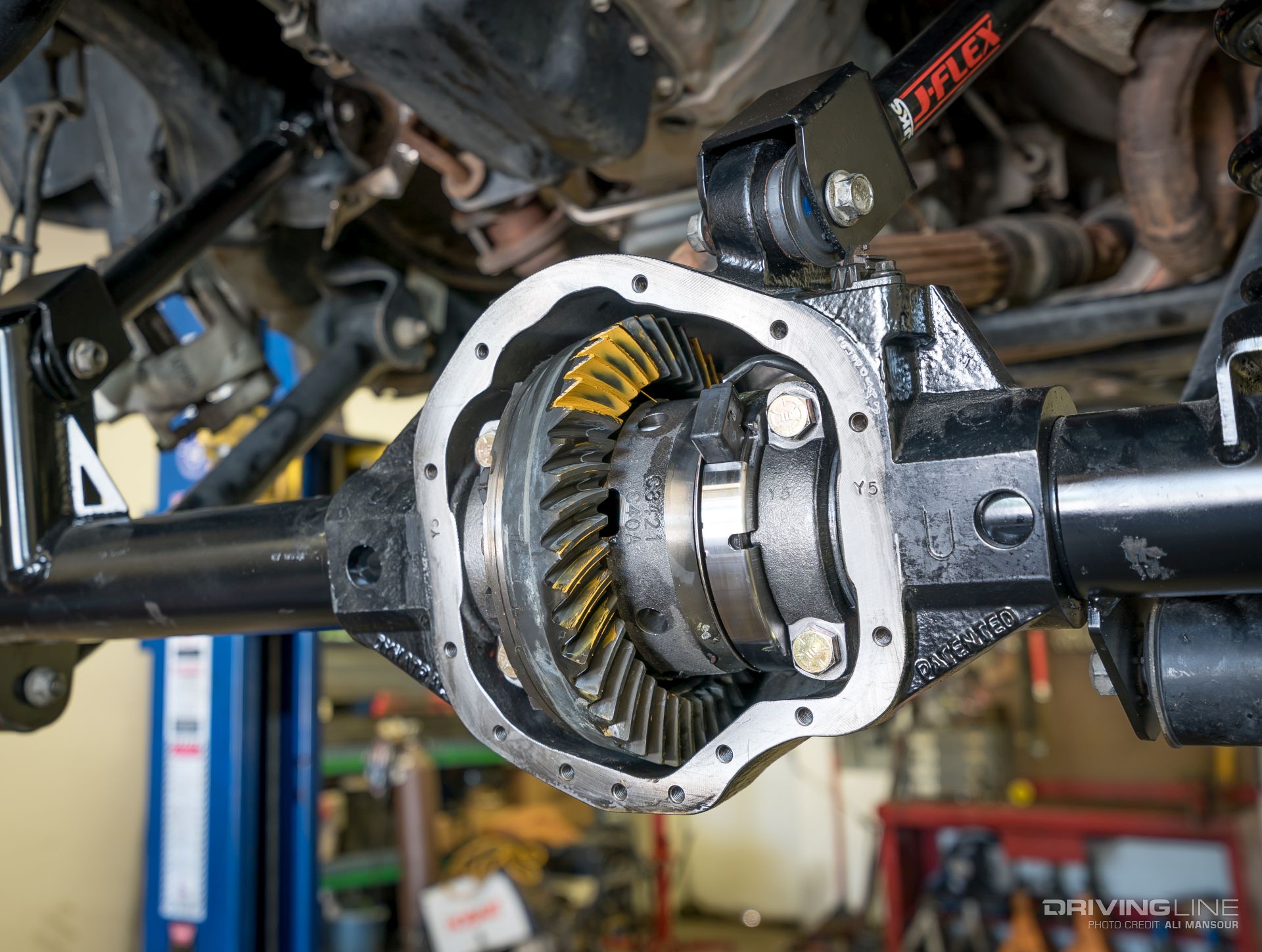
The Unlimited version of the ProRock 44 is built with extra caster for the differential. This is designed for those running 3 inches of lift or more. Since were are just shy of the lift cutoff, we used a set of JKS Manufacturing upper control arms to properly dial in the caster.

While drivelines are one area we’d like to upgrade down the road, for now, we retained our stock front ‘shaft. Since the ProRock 44 is built within the same dimensions as the stock JK Dana 44, there were no modifications needed fo the driveline.

You’ll retain your Jeep’s stock outer steering knuckles, unit bearings and brake assemblies with the ProRock 44. For a little more money, you can opt for Dynatrac’s chromoly axleshafts. This may be something we upgrade down the line.

Dynatrac not only makes the track bar bracket stronger; you can opt to raise the mounting location as well. To accommodate this higher mount, you’ll need to convert to a draglink that attaches atop the steering knuckle. We used a complete Drag Link Flip Kit from JKS Mfg., which included the necessary drill bit and knuckle insert.

The new JKS draglink attaches to the stock tie-rod end adjuster sleeve and bolts to the knuckle using an OE-style tie-rod end. This puts the steering geometry back in check, so we don’t have to worry about bump steer. You may notice that we’re not running a steering stabilizer. This is due to us testing PSC Motorsports' all new Big Bore XD steering gear. We’ll have a full review on that coming soon.

Given we are running a modest 2.5 inches of lift, we swapped in a set of new set of 3-inch bumpstops from JKS. This ensures we don’t have any contact between the draglink and the bottom of the Jeeps framerail at full compression.

With the axle in, we filled the differential with fluid and torqued all the bolts. To ensure you don’t overfill the diff, Dynatrac builds in an overflow port in the cover.

The entire swap only took a few hours at the shop. It was literally a bolt in affair, and after a quick alignment check, we were back on the road.

We have more upgrades and adventures in store for our JK, so we’re looking forward to hitting the trail with our new axle beef. Aside from an extremely tight and solid feel partly thanks to the new Dynatrac ball joints, there’s no real change in driving to speak of. While an axlehousing might not be the flashiest upgrade you do to your JK, it just might be one of the most important.

Find out more about the JK in the 2007 to 2017 Jeep Wrangler buyers’ guide.
Truck Norris: Possibly the Most 'Merica Thing on 4 Wheels
When it comes to rugged and badass American icons, Chuck Norris is definitely one of the names that comes to mind. Chuck became a household name as an impressive Martial Artist and hero of the Old West style action television series Walker Texas Ranger. So when Chuck Norris and Maverik teamed up to give away a truck that embodied everything that is Chuck Norris, Heavy D from Diesel Brothers reinvented his prized Duramax-powered '11 Chevy Silverado 2500HD named Zeus and created this monster for them: Truck Norris.

The first thing you see is undoubtedly the Chuck-approved American flag outer skin on the truck.

Under the hood is a Duramax 6.6L with an SXE363 turbo, upgraded headstuds and a PPEI tune.

The Fusion front bumper was modified by Sparks and fitted with two Monster Hooks, eight KC Hilites Flex Cube LED pods and a 12,000-pound winch.

A custom Sparks Motors roof rack with more KC Flex Cubes ties into the bed rack system, featuring a decked storage system. Also in the bed lies a 15-pound bottle of nitrous.

Up front is a McGaughy's suspension system with 6-inch extended control arms and FOA coilovers. The rear suspension consists of Deaver long travel springs and FOA bypass shocks.

The truck is rolling on 20-inch Trail Ready Beadlock Wheels and 40x15.50x20 Nitto Trail Grapplers — the perfect combination of toughness and gritty grip.

A truck this big and bad isn't easy to get into, so they installed some AMP Research power step boards for convenience.

This one-of-a-kind build is being given away this fall to one lucky winner. We can only hope whoever ends up with it carries on the badass, tough-guy legacy of Chuck Norris.
See more of Truck Norris in the photo gallery below.
Jeeps of Hazzard: A JK to Go Postal Over
Every project vehicle has its own set of challenges. For Hazzard Fab Worx in Spokane, Washington, its latest build presented a unique set of hurtles on an otherwise common build. While placing 1-ton axles and a long-travel suspension under a Jeep Wrangler JK is commonplace for the Hazzard crew, Jeff Bohrer’s 2008 Wrangler put everyone’s problem-solving skills to the test. Why? Well, this particular JK once served as a Postal carrier.
Its mail-delivery past translates to a steering wheel mounted on the right side of the vehicle. Sure, that may not seem like a big deal, but it’s something that the aftermarket doesn’t support very well. This meant the Hazzard team had to fabricate and get creative when installing big ticket items such as the Ultimate Dana 60 axle set and long-travel suspension.
We caught up with Hazzard Fab’s owner Luke Shuman in Moab, Utah, where we got the full rundown on the build. While the video above will offers an overview from the builder himself, we’re diving more into the details in the feature breakdown below.

Powering the JK is a fresh 3.8L V6 crate engine that was paired with a RIPP supercharger to help move the two-door along. Stainless steel headers along with a Mishimoto aluminum radiator were also added to the mix. Transmitting the power is the stock automatic transmission and NV241 transfer case.

Going with the Dana/Spicer Ultimate 60 front axle was a great way to add strength, but also created significant challenges since the axle was configured for a left-hand drive. One of the biggest issues was the track bar. Since it mounts at the axle on the passenger side, Hazzard Fab Worx had to create a custom bracket that would clear the massive 1-ton differential and allow the suspension to properly cycle.

While a PSC Motorsports hydraulic assist steering system makes pointing the 40-inch Nitto Trail Grapplers easy, getting the Synergy Manufacturing crossover draglink a place to land took a little work. To make everything come together, the Dana 60’s steering knuckle was machined to work with a custom high steer arm.

Out back, you’ll find a full-float Ultimate 60 fit with an Eaton ELocker and 5.38 gearset. Aside from strength, a major draw of the all-new Dana axle set was that they came with larger brakes. To get full potential out of the new brake set, a larger brake booster from a J8 was added on. Given the rear axle was pushed back four inches, a custom track bar and coil perches were fabricated.

Controlling the rear is a set of chromoly arms from Synergy Mfg. This high-clearance 4-link long arm works with a flexy 3-link front suspension. A bevy of custom and aftermarket skidplates keep the vitals protected, while Poison Spyder rocker guards keep obstacles at bay from the body.

Since highway driving was going to be just as much as part of the equation as the dirt, the suspension needed to be versatile. To accomplish this, progressive-rate coil springs were paired with King 2.5-inch bypass shocks at each corner. While the coils play an important role, the ability to adjust compression zones and fine-tune the rebound on the suspension is what allowed Hazzard to achieve such a dynamic on- and off-road suspension system.

Grip is king when it comes to wheeling, but equally important was a tire that could be massive and still have excellent street manners. Hazzard commonly opts for the Nitto Trail Grappler in the 40x13.50R17 as it has a proven track record off-road and retains all of the needed refinement you’d expect from a smooth-rolling mud-terrain radial. Ensuring they can get the most bite on the trail, without losing a bead are 17-inch Raceline Monster beadlocks.

Toting the fullsize spare is body-mounted carrier from Poison Spyder Customs. While the rear fenders are also from Poison Sypder, they were modified to accommodate the wheelbase stretch.

Aside from the obvious, the inside of the ex-postal Jeep remains similar to what you would find on a typically left-hand-drive model. While there are no power windows in this rig, there are some nice electronic upgrades. One of the more trail-worthy is the sPOD, which cleanly mounts the Jeeps locker and lighting controls above the rearview mirror.
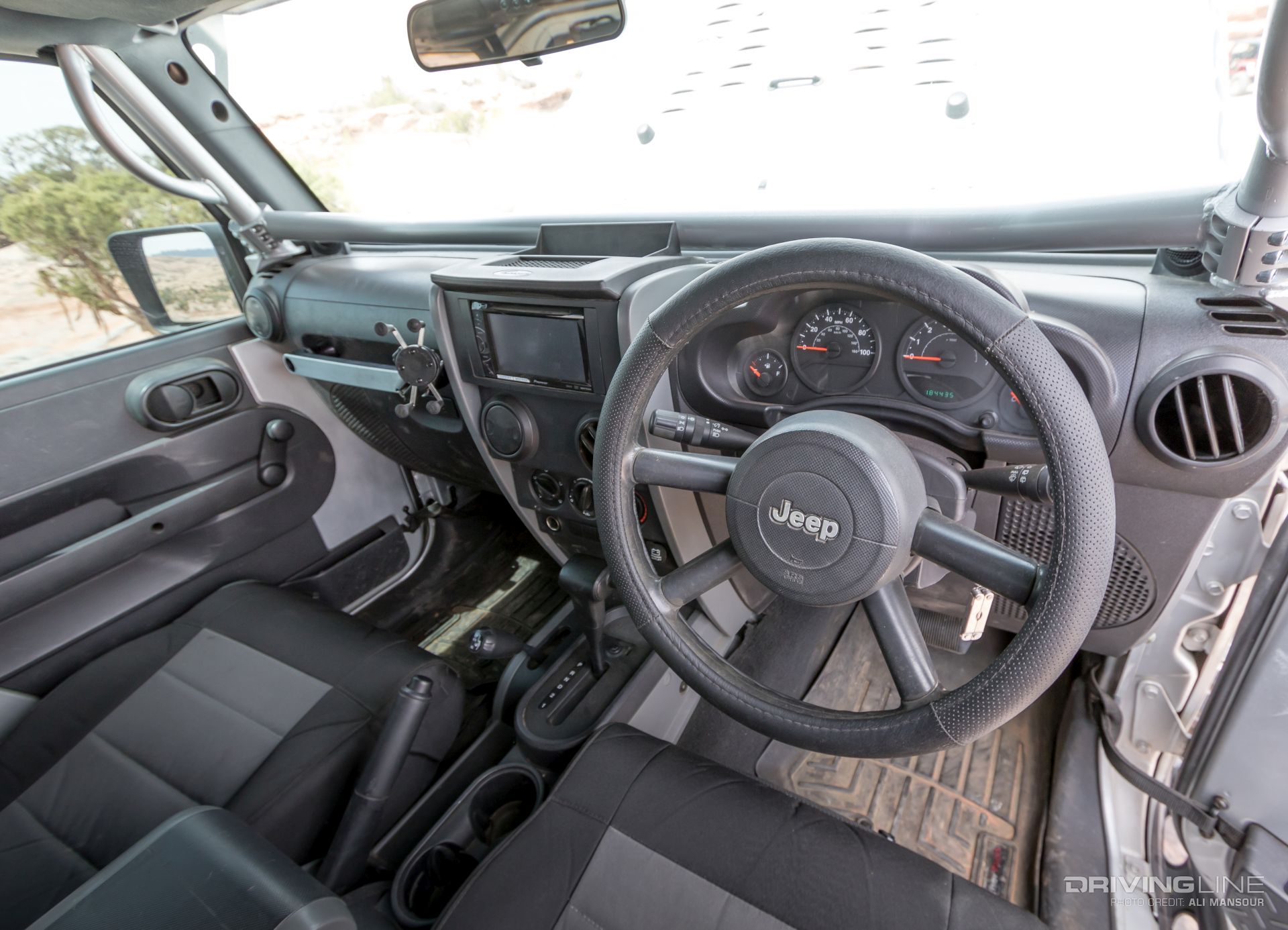
To clean up the stock seats and add place for extra gear, TrekArmor seat covers were added. Providing occupant protection is a bolt-in cage from Rock Hard 4x4.
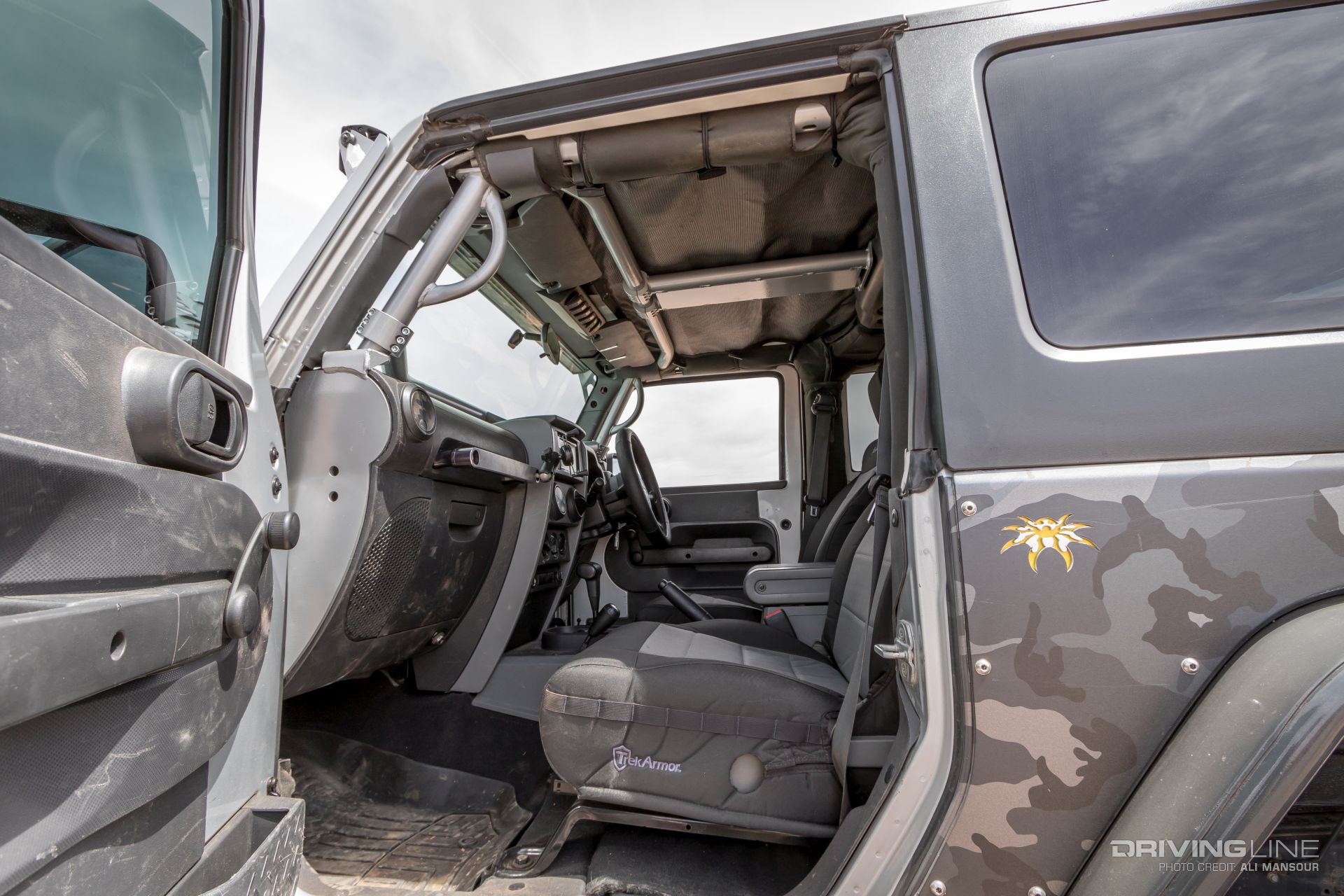
For a sound recovery tool, a Warn Zeon 10-s winch was secure up front to a Poison Spyder front bumper. Helping to light the way are headlights and an assortment of LEDs from Rigid Industries. While the modest lift help keeps the center-of-gravity low, Currie Antirock sway bars help with the stability of the rig in the dirt and on the tarmac.

Paying homage to its postal roots is a custom wrap. This is one JK that can live up to the postal creed with ease!

HARD FACTS
2008 Jeep Wrangler
| ENGINE | Ripp Supercharged 3.8L V6 |
| TRANSMISSION | 42RLE |
| TRANSFER CASE | NVG241 |
| FRONT AXLE | Ultimate Dana 60, Eaton ELocker, 5.38 gears |
| REAR AXLE | Ultimate Dana 60, Eaton ELocker, 5.38 gears |
| SUSPENSION | 3-link front w/coils and King 2.5 bypass shocks/4-link w/track bar rear w/coils and King 2.5 bypass shocks, Currie Antirock sway bars |
| TIRES | 40x13.50R17 Nitto Trail Grappler |
| WHEELS | 17x9.5 Raceline Monster beadlock |
| MISC. | Rock Hard 4x4 ‘cage, Rigid LED lights, Warn Zeon 10-s winch, sPOD, Poison Spyder bumpers and rocker guards, PSC Motorsports hydraulic assist steering, Synergy Mfg steering links, AEV ProCal, Mishimoto radiator, custom vinyl wrap |
Check out even more details on the Jeep in the gallery below.
After Hours Touge With Mad Mike at Ebisu [Video]
After a tough weekend at Formula D Japan Round 2 at Ebisu's West Course, Mad Mike needed to release some steam. Legendary drifter and owner of Ebisu, Mr. Kumakubo, suggested a trip through to the mountains. So that is exactly what he did and precisely where we followed him.
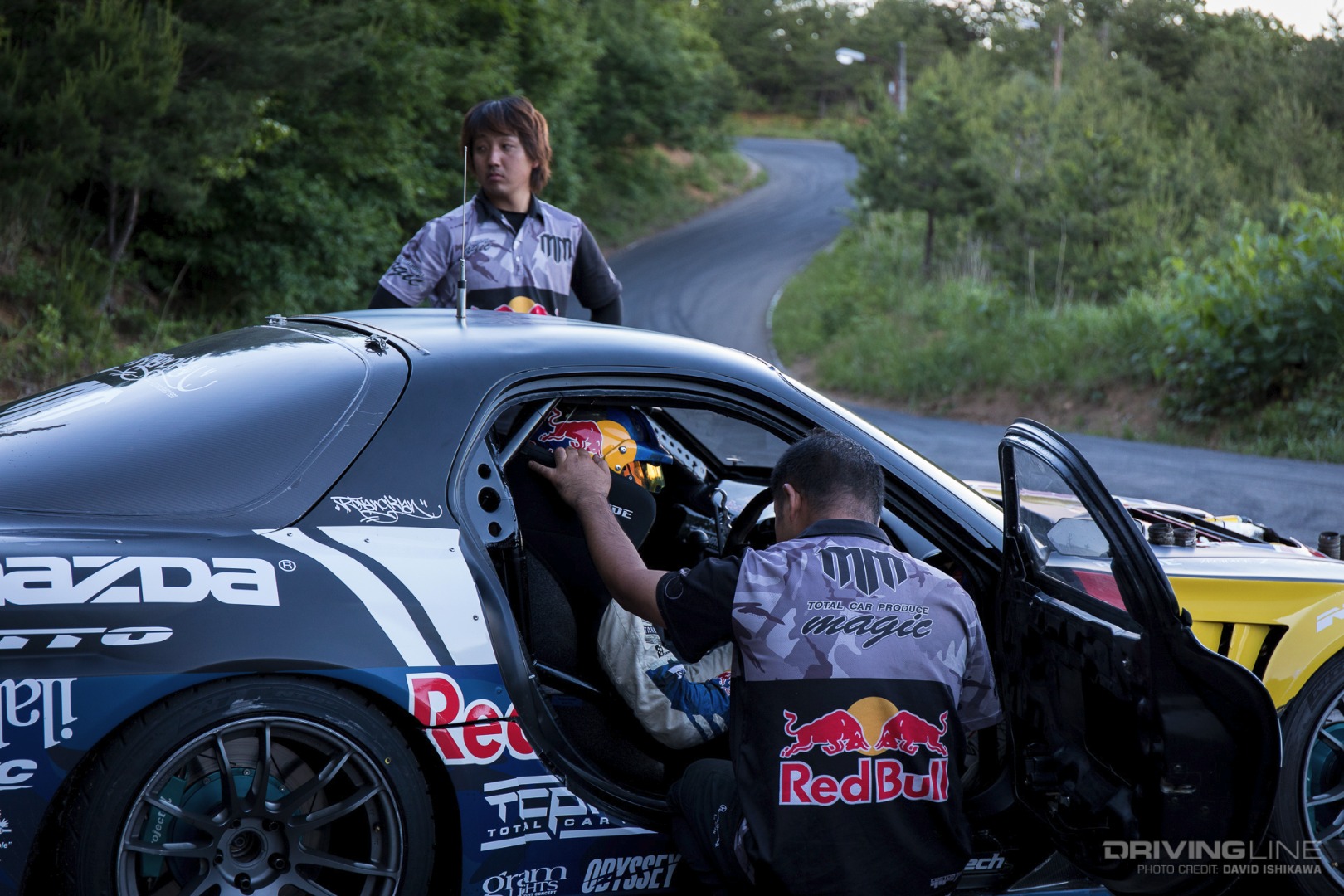
Tucked away in the vastness that makes up Ebisu Safari Park are seven different courses, including a touge course. The touge course simulates the many mountains that can be found throughout Japan and is a great place to try your hand before risking falling off the side of a mountain. As if it was a competition, Mr. Kawato and the TCP Magic team got Mike's car prepped to attack the touge course and after a couple of laps, Mike was ready to go.

With the sun illuminating the distant mountains, darkness started to envelop the touge course bringing with it a calming silence. The setting was serene, but that was soon to be broken as the distinct thunder of a twin-turbo four rotor came to life. BRAPP!
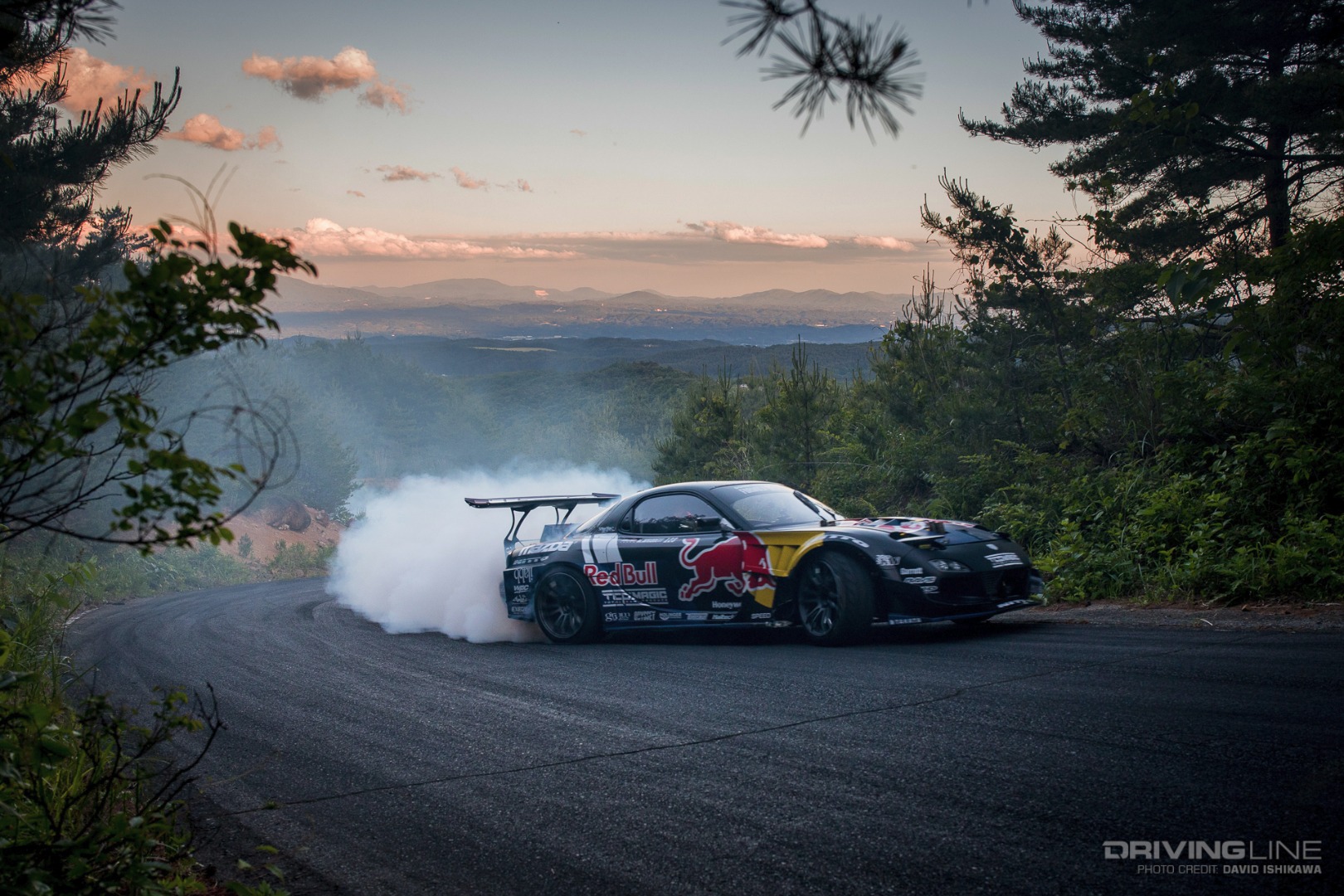
HUMBUL made its way through the course like the forest beast Nago from Princess Mononoke — snarling and screaming its way through, leaving a trail of smoke through the entire course. After a few passes, Mad Mike and HUMBUL had finished what it came to do, and silence fell once again in the mountains.
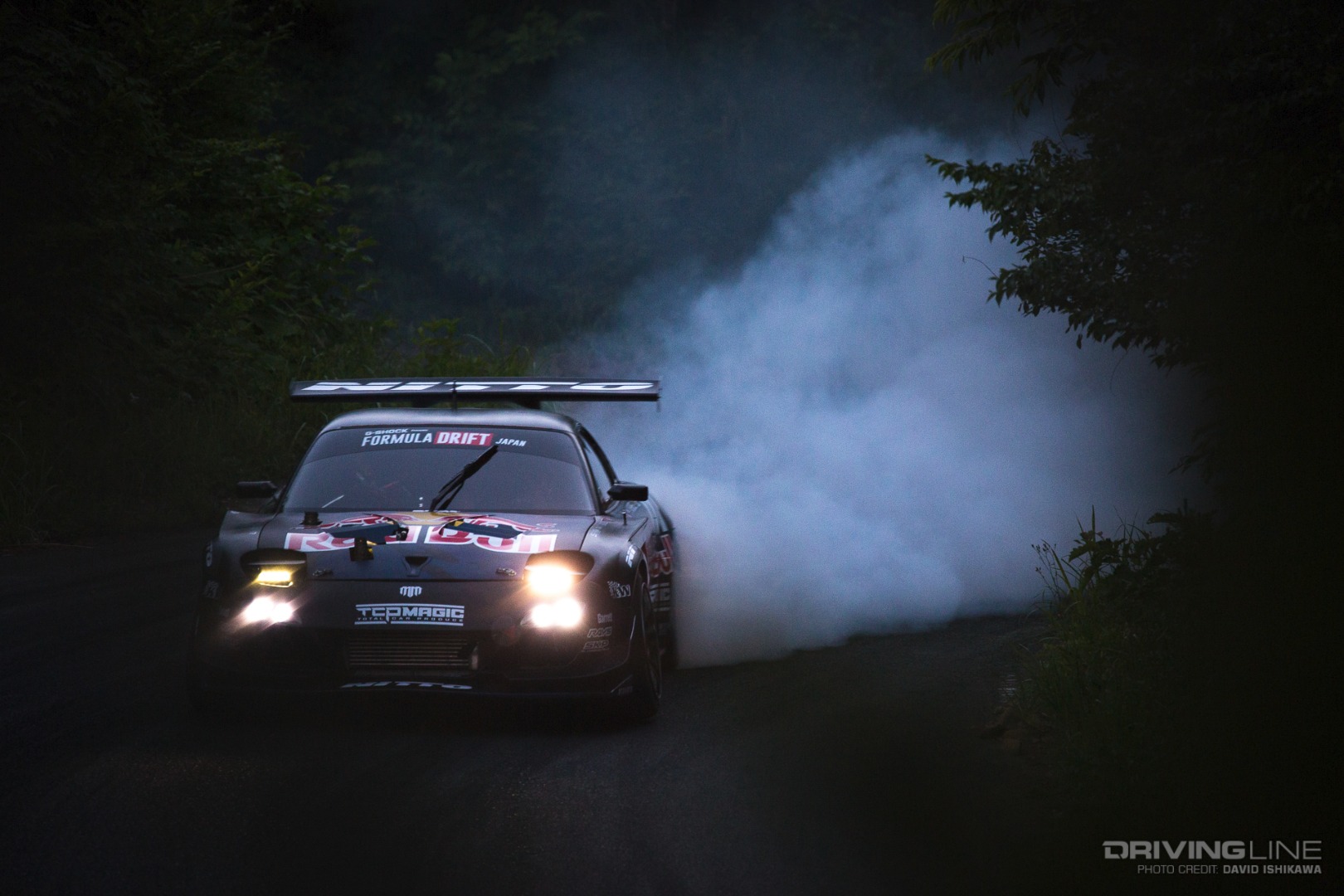
Take in all the excitement of Mad Mike's after hours touge session in Red Bull New Zealand's video. More shots in the photo gallery below.
Anatomy of a Pro Stock Diesel Truck
Building on our “Anatomy of” theme, this installment sheds some light on the ultra-competitive Pro Stock class in diesel truck pulling. Unlike the multi-turbo, fiberglass body Super Stock category, in Pro Stock restrictions are placed on key power-making components such as the turbocharger and injection pump, with frame and body limitations in place as well. While not quite as extreme as the 3,000 hp Super Stocks, the Pro Stock trucks are arguably more consistent and predictable. In this class, sled pulling is no longer a game of feet, but a game of inches. It’s not uncommon to see the top 10 finishers at a national event be separated by only a few feet.
Follow along as we award this dynamic class its well-deserved 15 minutes of fame.
All-Iron Engines
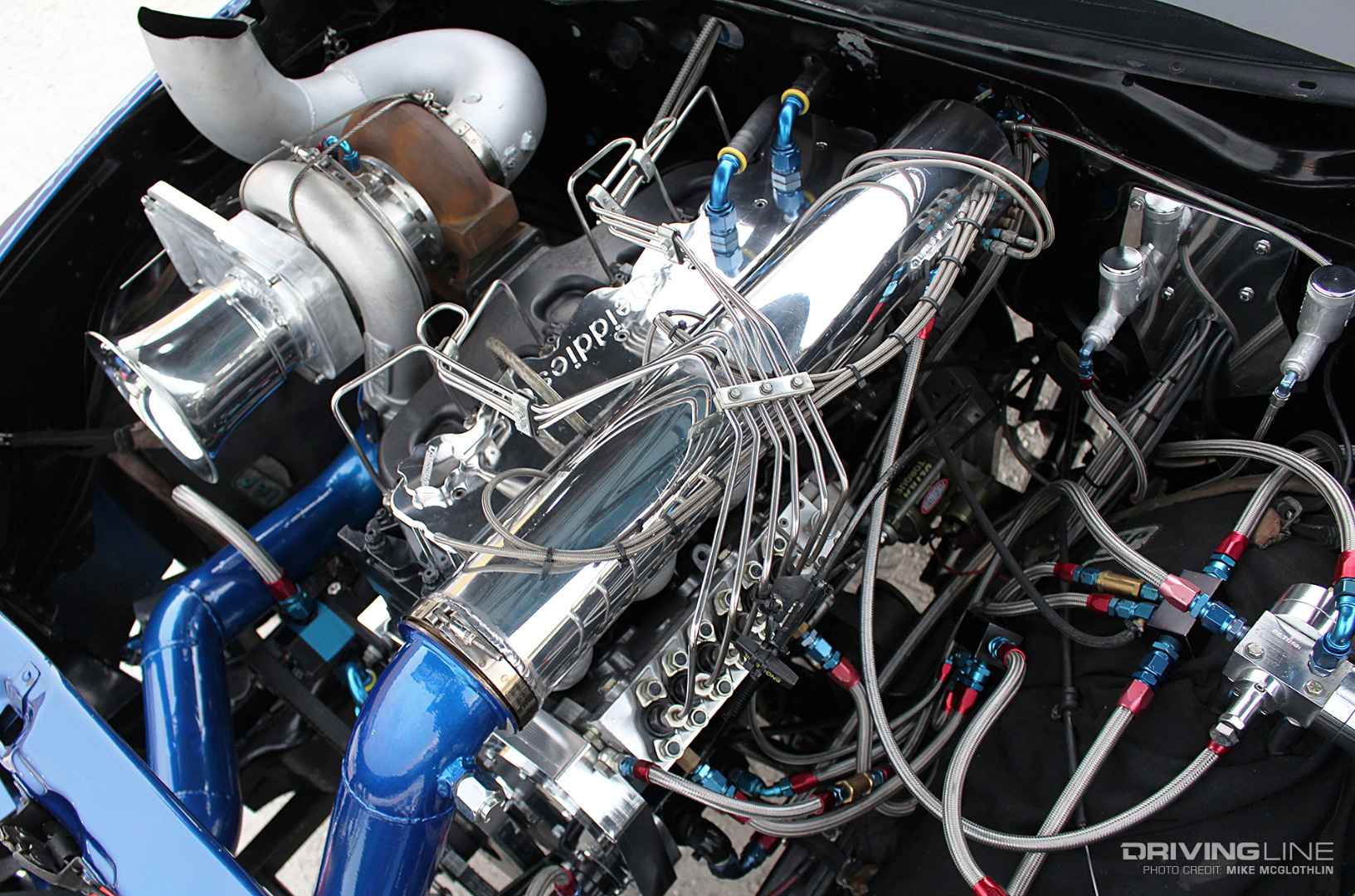
Unlike the Super Stock class, aftermarket blocks aren’t permitted in the Pro Stock category. As a result, factory-based cast-iron crankcases — such as the 6.7L-based Cummins shown here — are heavily reinforced. The water jackets are filled with concrete, the crankshaft is secured via girdle, billet connecting rods and low-compression pistons are used, the cylinders are sleeved and deck plates are employed. Scheid Diesel and Haisley Machine all but own the Pro Stock class as far as engines are concerned, and the two companies are constantly duking it out for the top spot in an unbelievably competitive field.
High-Flow 12-Valve Head

With no billet blocks (of any material) being allowed, it stands to reason that no billet-steel or billet-aluminum cylinder heads are allowed in Pro Stock either. However, OEM or OEM cast replica heads are permitted, which makes the cast-iron 12-valve piece from Hamilton Cams one of the go-to items in this class. Thanks to a thicker deck and more material around the ports than what you’ll find on an OEM 12-valve head from Cummins, the Hamilton War Head can be opened up in a big way via CNC porting. In fact, a thoroughly worked over version (complete with larger valves and a complementary high-lift cam) can flow more than twice what a factory unit can (310 to 340 cfm vs. 150 cfm stock).
3.6-inch Smooth Bore Turbo

In the Pro Stock field (and just as is the case in the Pro Stock tractor category), only one turbocharger can feed the engine. For the Pro Stock diesel trucks, the turbo must be of a smooth bore design, no map groove can be present and the compressor wheel inducer can measure no larger than 3.6 inches (91.4 mm). It’s typical for a charger in this class to produce 55 to 65 psi worth of boost. While it’s a far cry from the 120 to 150 psi the compound and triple-turbo engines in Super Stock ingest, the milder boost levels the Pro Stock engines see afford them exceptional reliability. Most competitors opt for a refresh each winter, but we wouldn’t put it past a Pro Stock engine to survive two full seasons (if not more) of abuse without a rebuild.
Cooler Air = More HP

One of the more overlooked components on a Pro Stock rig is the type of intercooler most competitors use. Of a water-to-air design, these multi-core units (available through Precision Turbo & Engine, Frozen Boost and others) require the use of an auxiliary water pump and an ice box in order to function, but they’re known to drop the temperature of the compressed air leaving the turbocharger by more than 400 degrees. Most water-to-air intercooler systems provide for 60 to 75-degree air to enter the engine (vs. 500 degrees). It’s not uncommon for more than 100 pounds’ worth of ice to be consumed on one pass. We’ll note that water injection is also allowed (and employed) in Pro Stock, to keep exhaust gas temperature in-check.
13mm and 14mm P-pumps

Injection pump stipulations dictate that P-pumps can be run so long as just one plunger exists per cylinder (i.e. dual plunger pumps are illegal), but the exotic Sigma pumps found in the Super Stock aren’t permitted. One of Scheid Diesel’s 14 mm P8600 P-pumps is shown in the photo above, which incorporates 14 mm plungers and barrels, a quick-rate cam and an Ag governor that provides full fueling past 6,000 rpm. Other popular injection pump choices in the Pro Stock class include the 13 mm versions offered by Northeast Diesel Service and Hart’s Diesel. Most injection pumps send fuel to custom, triple-feed injectors with 5-hole, SAC-style nozzles.
Reverser Transmission

Just like the Super Stock class, the one-speed reverser transmissions and quick-change transfer cases offered by Pro Fab Machine and SCS Gearbox are utilized by all Pro Stock competitors. A Pro Fab reverser can be seen above, positioned directly behind the blow-proof bell housing in Daniel Whalen’s ’01 Dodge, a truck named “Cumminzed Out.” Also similar to the Super Stock field of trucks, Pro Stocks are typically fitted with a four-disc clutch from either Hays, Crower or Molinari Racing Products.
100 Percent Sheet-Metal Body

Fiberglass body panels are prohibited, but removable panels are not — hence the use of them here for serviceability purposes. And while trucks can be fitted with an aftermarket hood, it too must be sheetmetal. We’ll also point out that 0.060-inch thick engine shields that span the length of the block have to be used for safety purposes, which equates to running a steel inner fender.
Shedding Weight

Just because the rules state the factory sheetmetal body has to be retained doesn’t mean you can’t cut weight in certain areas. And by cut, we mean cut loose… Take the interior of Todd Cox’s ’80 Chevy, for example, in which he cut out the cab floor entirely and then took a hole saw to the interior. As a result of all of his handy work (along with removing the dash, and rear and side windows), he was able to trim more than 400 pounds out of the cab and then relocate it where it needs to be — forward of the front axle, in the weight box.
OEM Frame

One of the biggest differences between the Pro Stock and Super Stock trucks rests in the chassis. While a tube chassis frame can be employed (and almost always is) in Super Stock, Pro Stock competitors must retain the full OEM frame, from axle to axle. But even though the sheetmetal bed has to be left alone, rules do permit the bed floor to be cut out in order to shave weight. Remember, the goal in all truck pulling classes is the same: Get as much weight forward of the front axle as possible. The maximum weight allowed for trucks competing in Pro Stock is 7,800 pounds (vs. 7,500 pounds in Super Stock).
Axles Built for Battle
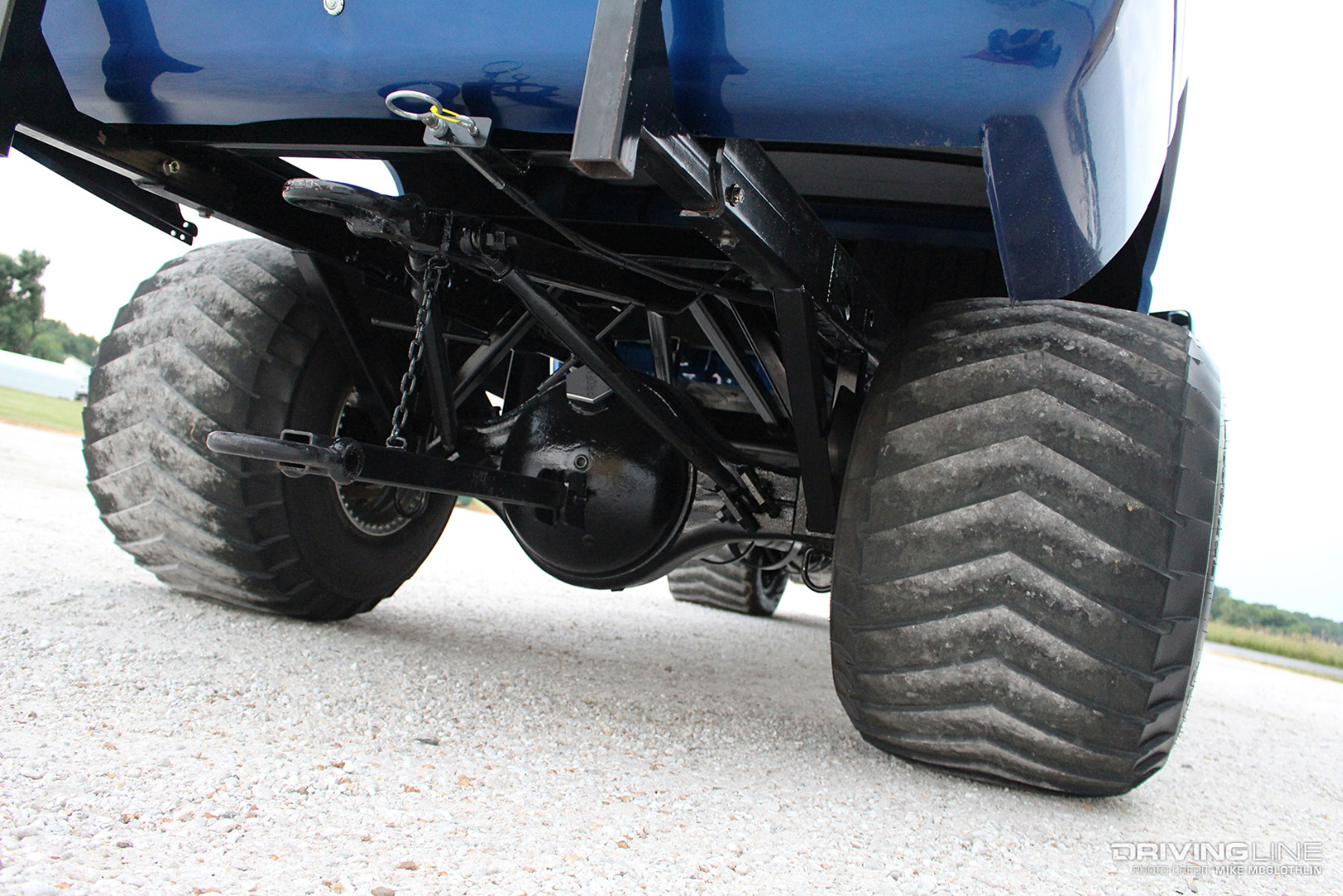
Other than planetaries being prohibited, no limitations are placed on front or rear axle choices. Armed with this freedom, most competitors opt for the strongest and most common rear axle used in truck pulling today: the Rockwell SQHD. Gun-drilled axle shafts, spools and lighter-weight hubs are employed in an effort to reduce weight and keep each wheel digging. Up front, it’s common to find a Rockwell 106 that’s been fitted with steering knuckles, but a lot of trucks (namely Dodge Rams) still sport the factory-based Dana 60.
Suspensions Geared Toward Maximum Traction

While the rear suspension is rigid (i.e., non-existent) on Pro Stock trucks, it’s not uncommon to find a four-link configuration up front. This burley setup effectively loads the top arm and pulls in the bottom one in order to keep the axle housing from rotating under load. On this particular truck, two adjustable AFCO shocks reside on each side up front, allowing the owner to fine tune the suspension to his specific needs.
Aggressive, Cut Tires
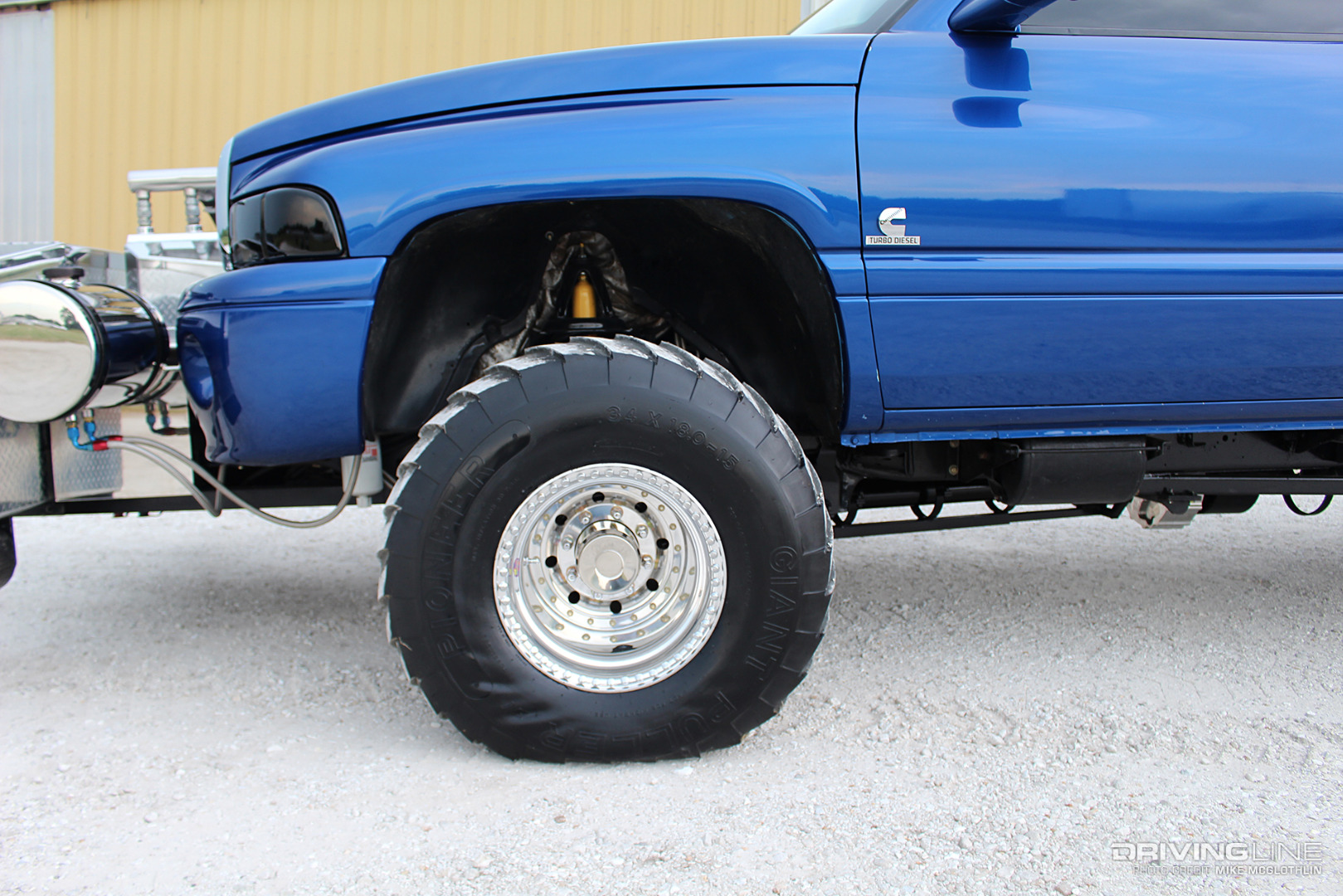
Although both DOT-approved tires and cut tires are legal in the Pro Stock class, most competitors opt for cuts. Just like in the Super Stock field, the traction that bar tires provide is far superior to what any DOT tread pattern can offer in the dirt. And (once again) just like in the Super Stock class, Real Racing Wheels measuring 15 inches in diameter can essentially be found on all Pro Stock trucks.
Here’s where you’ll find the hottest-running Pro Stock diesel trucks competing this summer:
Lucas Oil Pro Pulling League Schedule
| DATE | EVENT | LOCATION |
| July 6 | Midwest Summer Nationals | Freeport, Illinois |
| July 8 | Southeast Illinois Summer Heat | Fairfield, Illinois |
| July 21 | Montgomery County Fair | Montgomery City, Missouri |
| July 22 | Platte County Fair | Platte City, Missouri |
| July 26 | PPL Pull | Holland, Michigan |
| July 27 | Elkhart County Fair | Goshen, Indiana |
| July 29 | Rocky Top Diesel Shootout | Terre Haute, Indiana |
| September 23 | Macon County Truck Pullers | Lafayette, Tennessee |
| October 6-7 | Rudy’s Diesel Truck Jam | Julian, North Carolina |
See the full PPL schedule at ProPulling.com.
Double Trouble: #BroStangs Team Up to Conquer Formula Drift
With the 2017 Formula Drift season entering its final stretch, we caught up with Vaughn Gittin Jr. and Chelsea DeNofa to talk about their season so far; it’s the first they’ve been teamed together as Team RTR. We asked them both about their experiences driving RTR Mustangs, working together as new teammates, their goals for the remaining events and more.
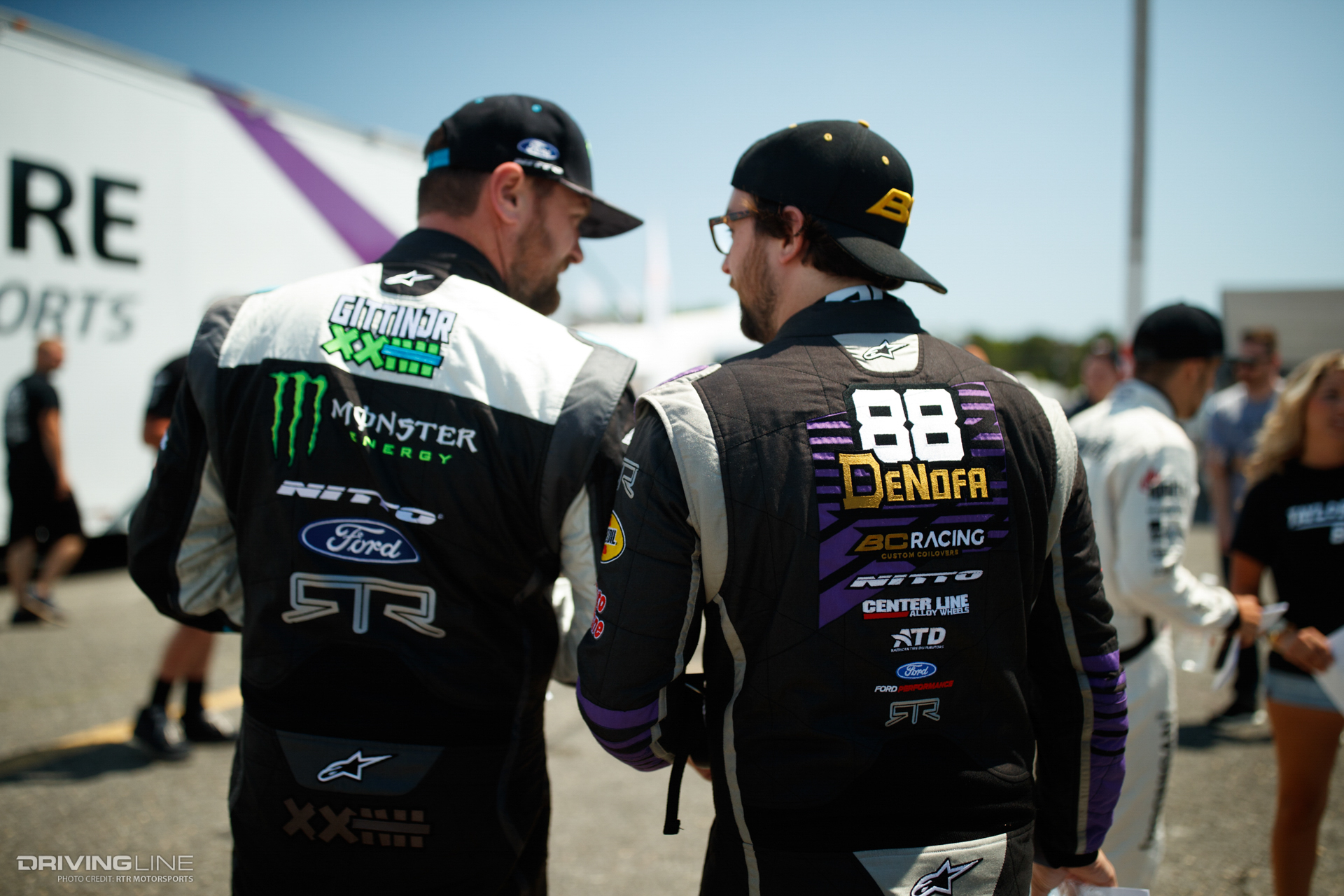
Driving Line: Obviously, making the jump to a two-car team for 2017 was a big step for you. What has been the most challenging aspect of adding a second RTR Mustang to the stable this season? Is there additional stress besides just focusing on your own performance?
Vaughn Gittin Jr.: There is a lot of "new" for everyone this year. New team members, new Ford Performance/Roush Yates engine program, new Bosch ECU with serious data capabilities. Things really started to settle in at Round 4, and now we’re approaching where we want to be.
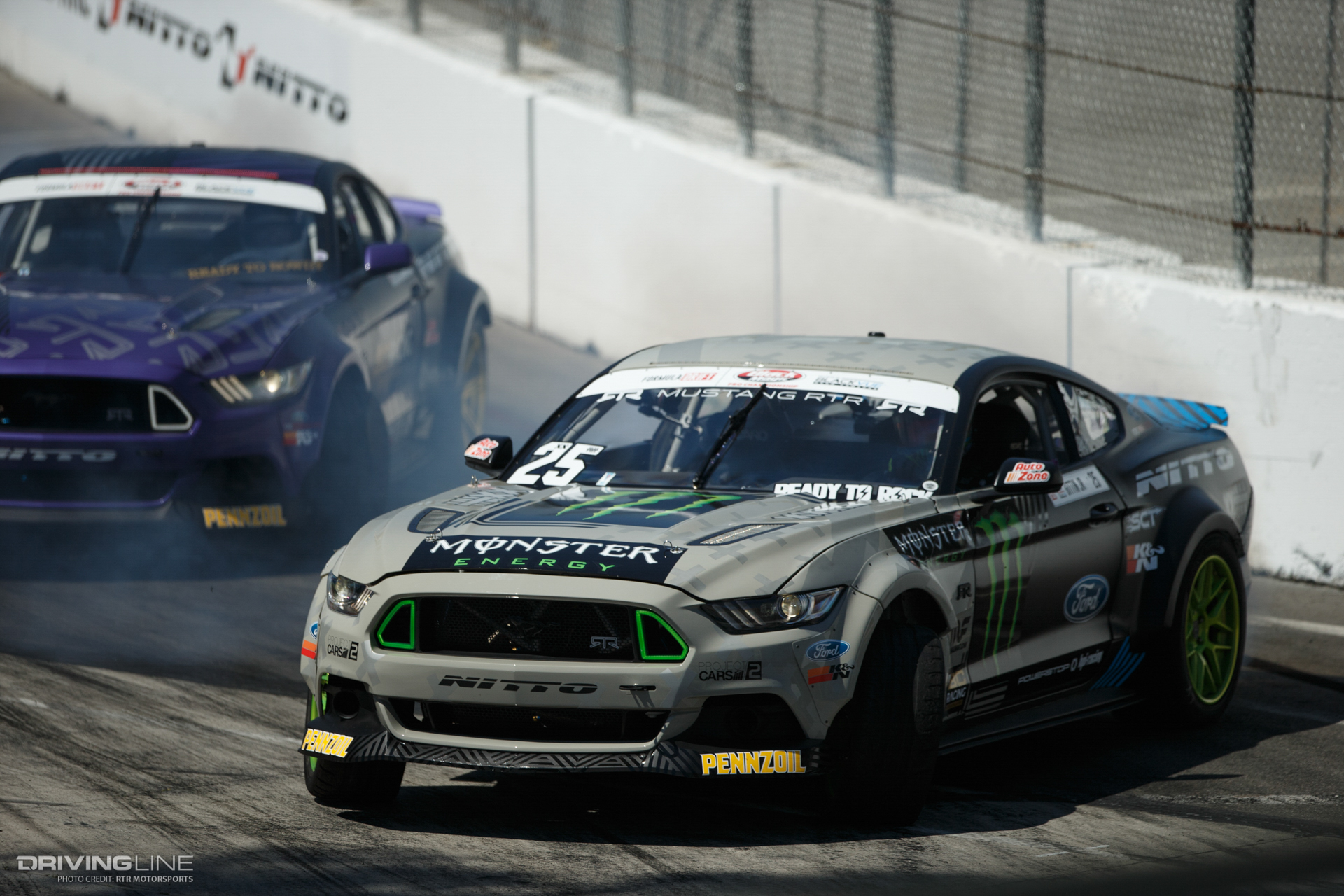
The biggest challenge has been taking advantage of the data that can be shared between the two cars. That is new to us and it took us longer than expected to fully leverage. Getting the cars set up for each track very quickly allows Chelsea and I to focus on dialing in ourselves behind the wheel. I don't feel any additional stress; this entire process has been a lot of fun and rewarding. I am really enjoying having Chelsea on the team and watching him go through some of the changes I went through when I started running with this caliber of team.
DL: Compared to your past experiences operating your own team, how have you benefitted from working directly with Vaughn?
Chelsea DeNofa: It's been an awesome change-up. Previously, I was the driver, logistics manager, chassis guy, engine builder, tire mounter, crew chief, marketing guy, et cetera. Now I fly in, do my homework, promote and make brands rad and drive. This has helped me become more professional, both behind the wheel and off-track. It's so awesome to have a team you can trust with the career you’ve been building since high school.
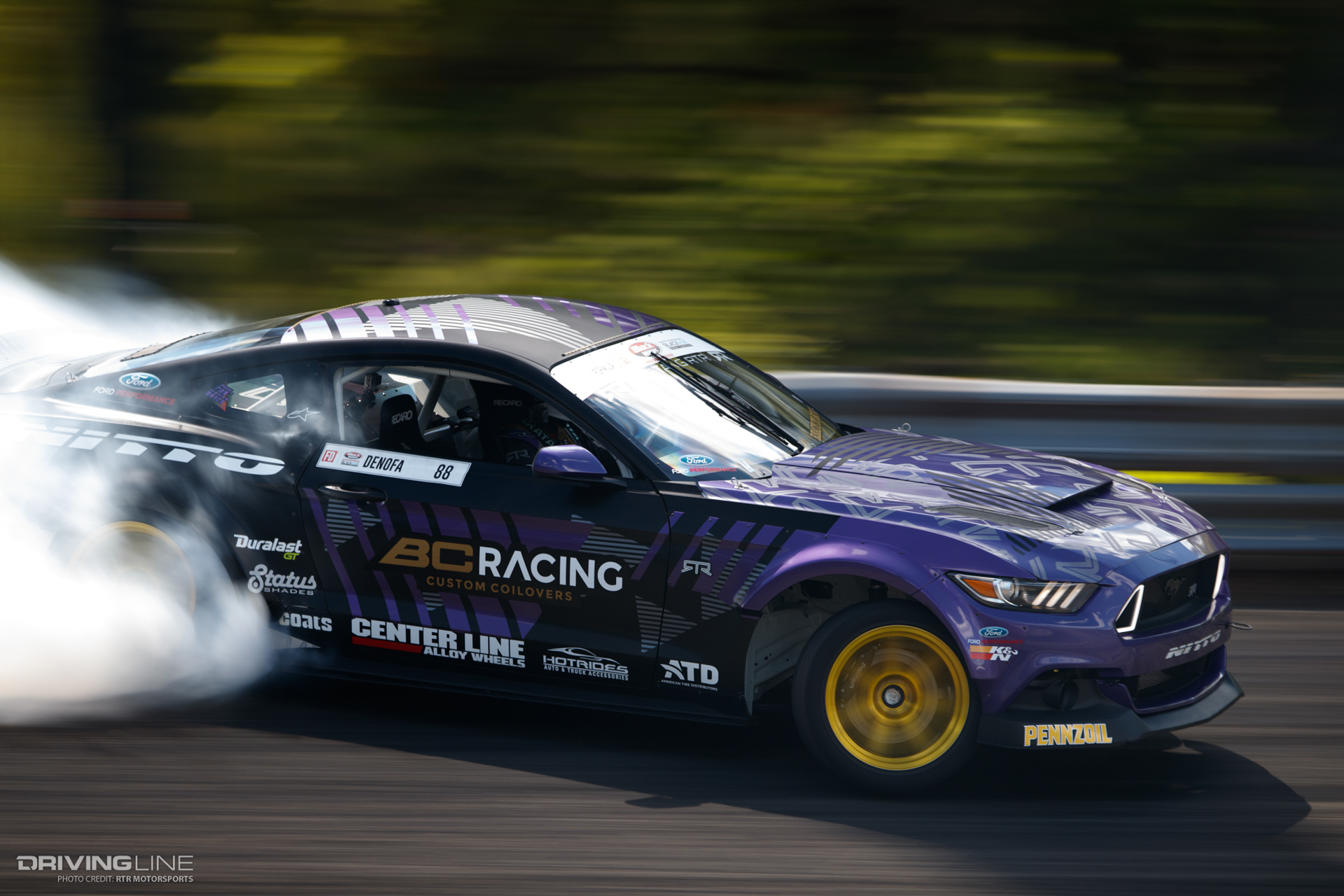
DL: What is the biggest thing you’ve learned working with Vaughn and his team this year?
CD: How to have an awesome time at the track! These boys know how to do their job with low stress and high enjoyment. I have also learned the importance of having your mind right and keeping myself focused on mine and the team's goals.

DL: Have you felt more pressure moving to the new team and new vehicle, or has having the additional support made it easier to simply focus on your performance behind the wheel?
CD: I have always wanted to win. If I didn't think I could win, I wouldn't be doing it at this level. That being said, the pressure is low — just as it's always been. When it's time to go, I'm relaxed, focused and ready to shred.
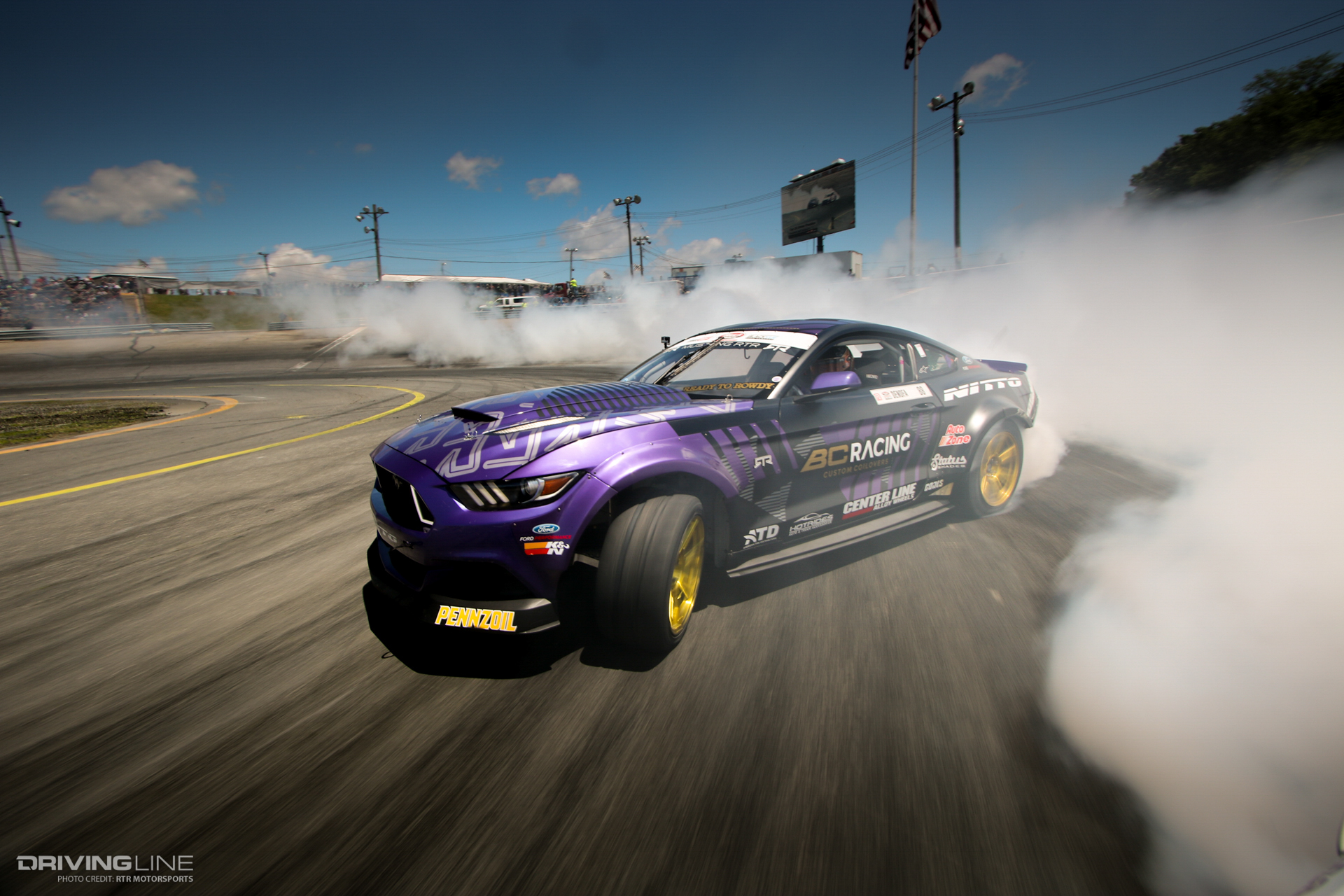
DL: Your support crew also has a lot of extra work this year with a second car in the mix. How have they handled the adjustment of moving from one car to two?
VGJ: I have an amazing team of guys with experience running multiple cars that have stepped up to the plate; it's very impressive to see. We had to add a few guys to the team for event weekends to support the expansion. Everyone is very passionate about what we do and that makes it fun.
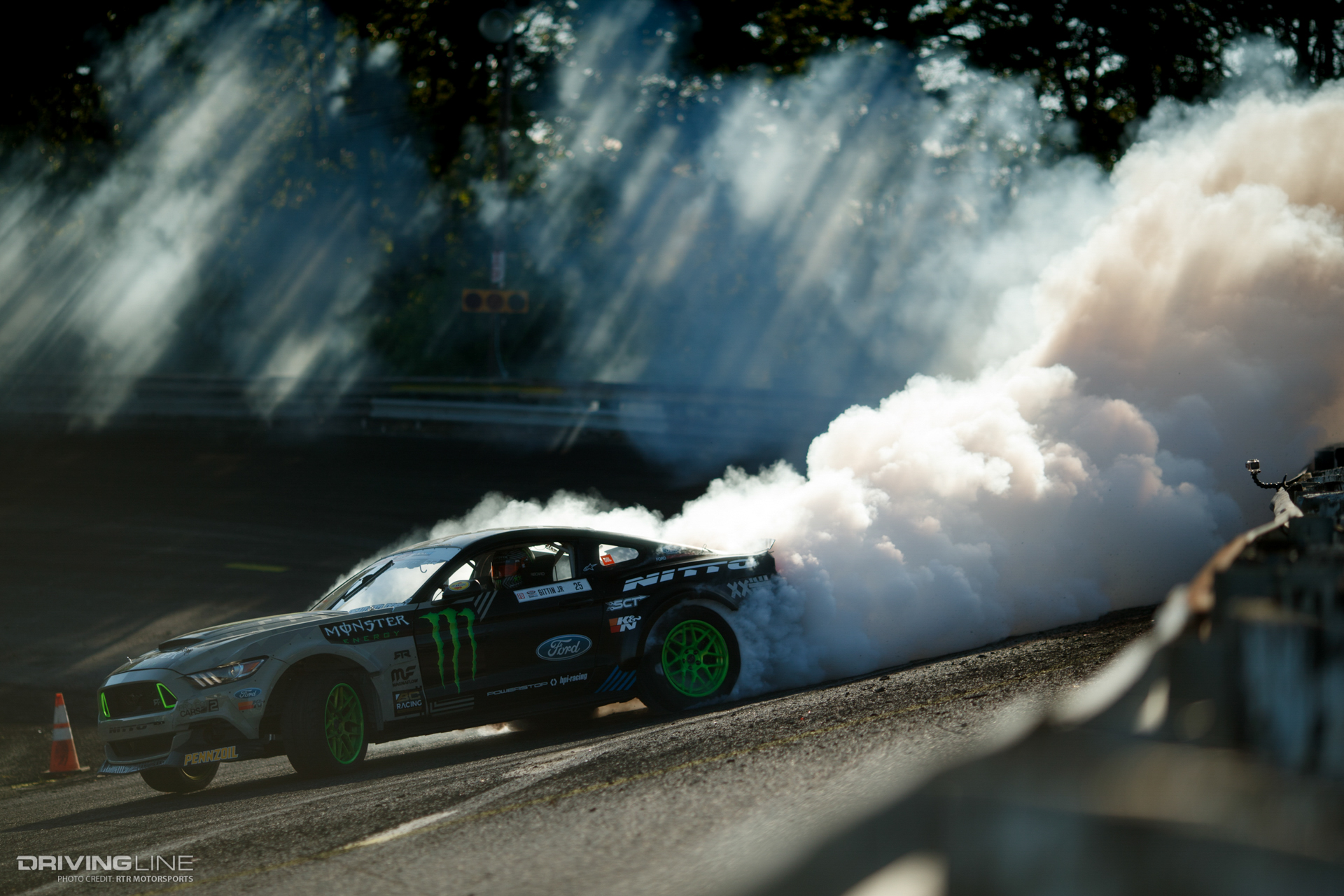
DL: How much information is typically shared between you two at an event? Has this benefited you in comparison to running as a single-car team?
VGJ: We’re still working on how to best leverage the two cars to get maximum benefit. It's easy to run in circles with different driving styles and approaches to the tracks. There have been some benefits here and there versus a single-car team, but I expect that to increase significantly as time goes on.
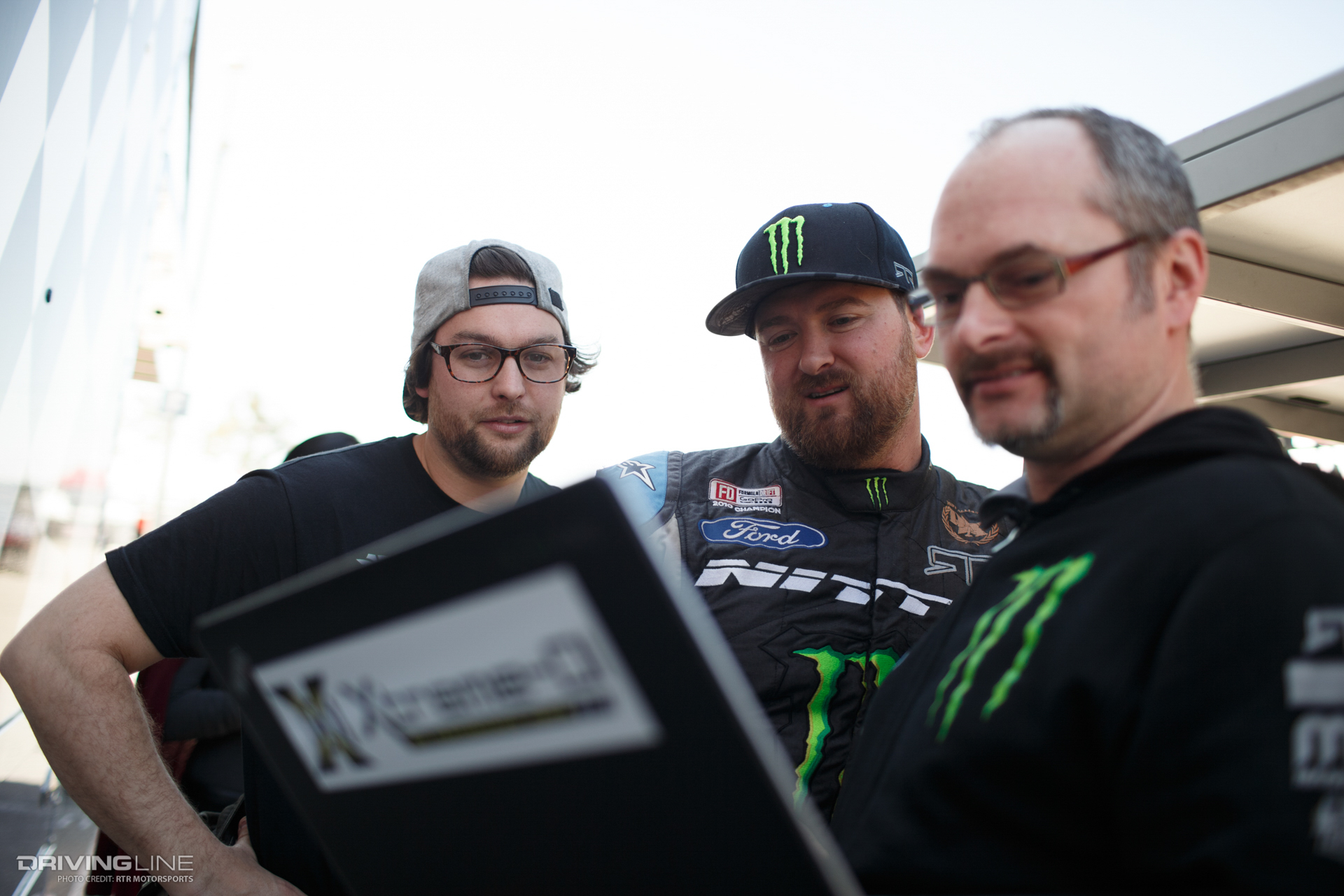
CD: We share everything related to the cars: data acquisition, shock setup, tire pressures, temps, as well as lines, speeds, angles and much more. Vaughn and I have very different driving styles, but we know how to curve the results to make improvements on both cars. Each lap I take benefits Vaughn and vice versa.
DL: The first half of the 2017 Formula Drift season has been filled with both ups and downs, how you would you summarize your performance so far? What would you like to improve on?
VGJ: I am happy with my performance behind the wheel. I feel better behind the wheel than ever. We have just missed some key setup elements that showed when it mattered. We will improve on making sure that we get the setups in the car needed to win for the rest of the season.
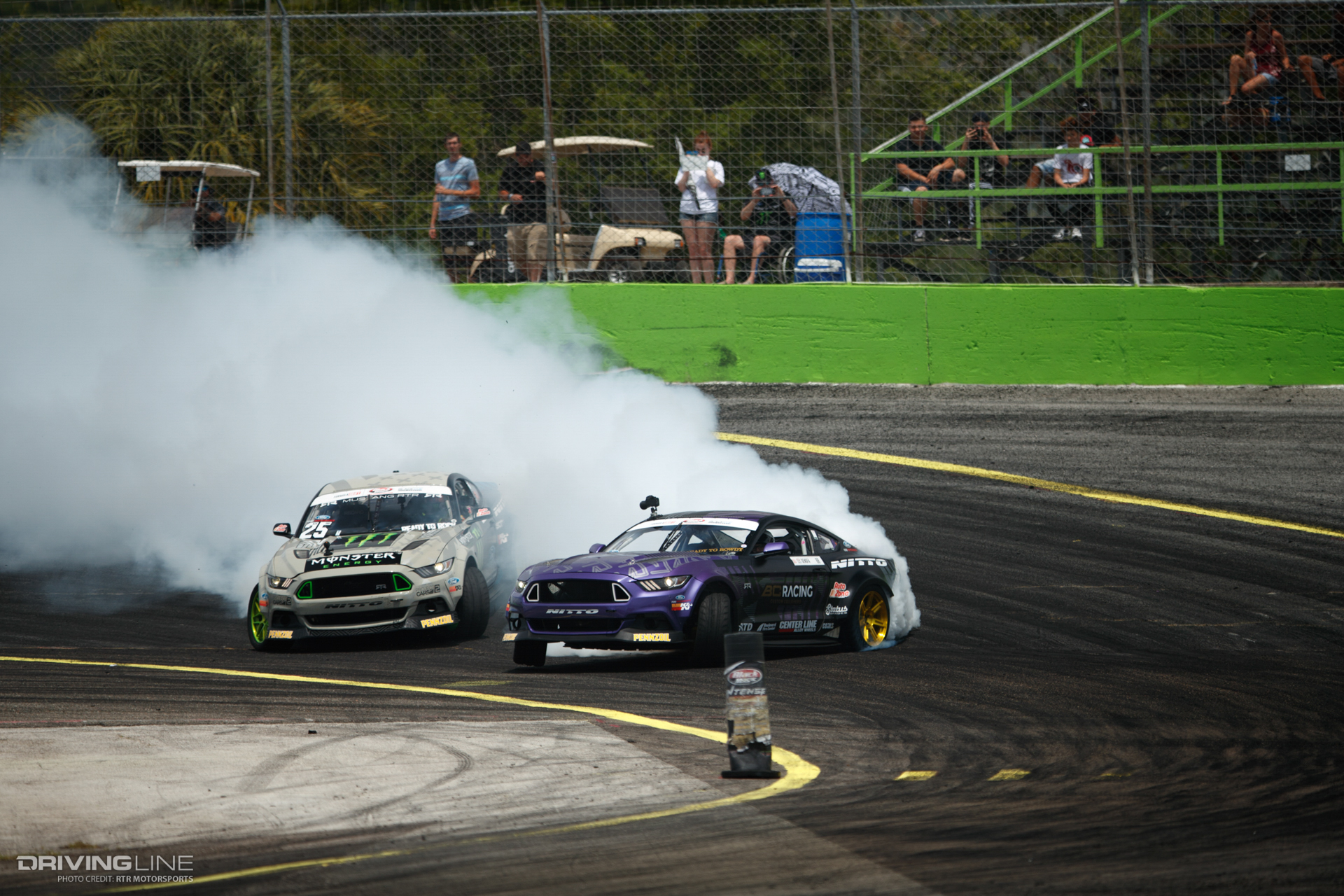
CD: We haven't had many downs! Every lap I am still learning and taking in what the car and team has to offer. I feel as though the team and I are progressing extremely fast — faster than I expected, to be honest. My goals are being reached quickly and precisely.
DL: How would you rate Chelsea’s performance so far?
VGJ: I am really pumped on Chelsea's performance thus far. There are a lot of new things to him — for example, everything. We knew this was going to be a development year for him to align with how we do things and our approach to Formula Drift competition. We are close to that breakthrough for him that I went through some years ago. He is gonna consistently be a serious threat to everyone very soon.
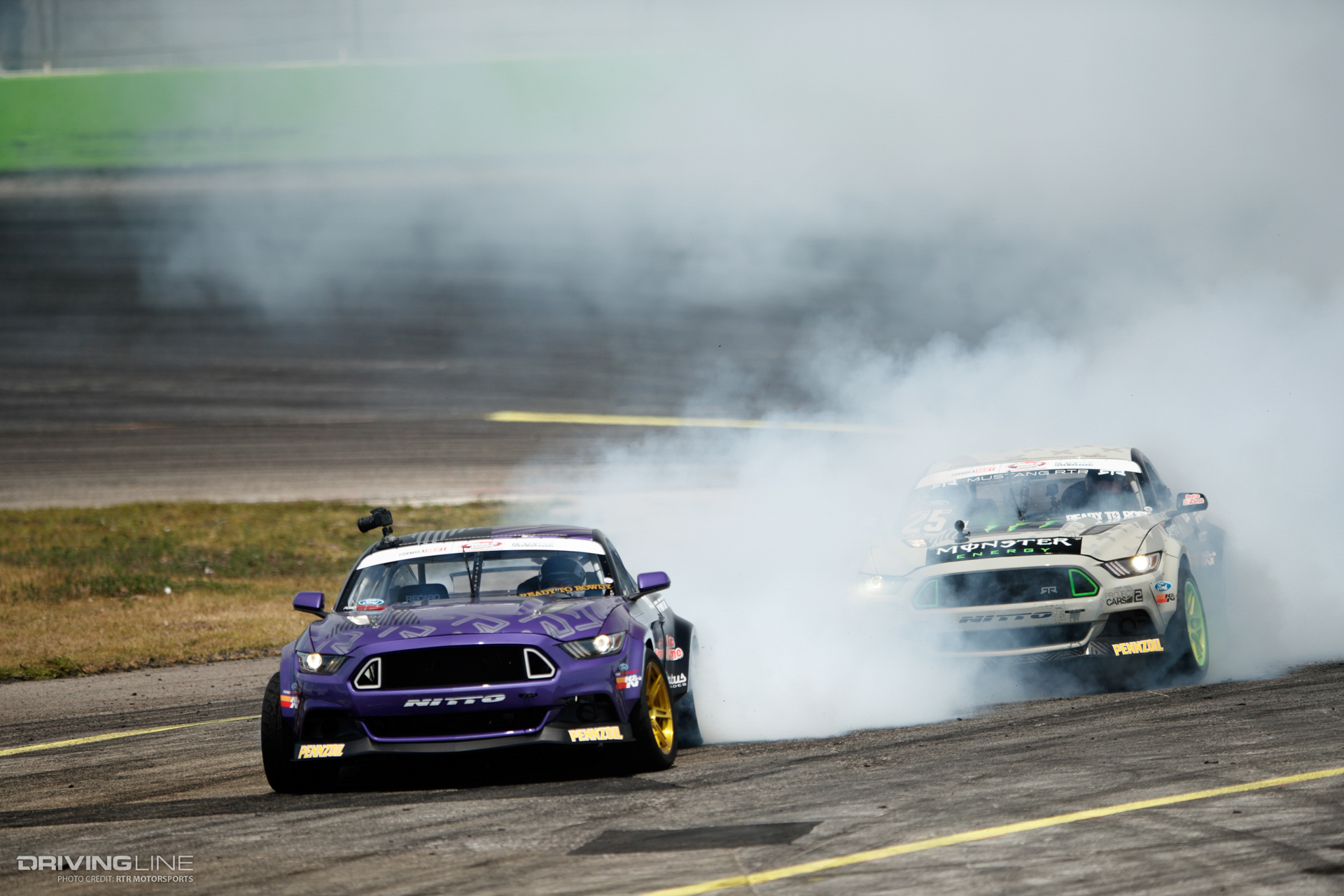
DL: Where would each of you like to be sitting when the smoke settles at Irwindale in October?
VGJ: I am not sitting where I would like to be at this point in the year, but we will continue to fight hard and see where we end up. I would like to see both of us on the top of the podium before the season ends.
CD: I have learned about 80 percent of the car at this point. To put it into perspective, I feel as though I have reached a level of comfort that took four years to build in my previous vehicle. My goal has been to podium an event this year. I'd like to finish off the season feeling that I am one with the car and as though I have a chance to beat any of my competitors — especially Vaughn!

(Photos courtesy of RTR Motorsports)
See more photos in the gallery below.
D1 Grand Prix: Round 3 at Tsukuba Circuit
It's rainy season in Japan, so it was no surprise to see a few dark clouds looming overhead that day. Fortunately, the weather stayed clear, allowing the drivers to do what they do best: Lay down lots of smoke on the high-speed entries.
Tsukuba TC2000
The course layout was broken into five sections with the drivers starting just before the final sweeper before the straight and start finish line.

Drag racing their way off the line, the drivers build speed and begin to break traction midway through the sweeper, which leads to a chicane and then into Tsukuba's turn one. At turn one is where most of the problems occur due to over-speeding into the corner.
Driver's do not connect turn two into turn three, but instead build up speed to hit turn four, then flick the car back as they enter turn five and six where the drift course ends. To see all the action, one has to be up pretty high, but most want to see the action from turns four to six.
Tanso
The day began with the top 32 drivers making two runs to narrow the field down to the top 16. During this time a few drivers struggled after the chicane — either over-speeding or not carrying enough and losing their drift. Hibino scored the best qualifying run with a 100.15 in his new Honda S2000. Better than perfect.

Bracket to the Final 4
#1 Hibino went up against #16 Hayashi in his Toyota 86. Everything was going smoothly until Hibino came in too quickly into turn five, forcing him to scrub his speed and straighten out. This gave Hayashi the win and the biggest upset of the day.

#8 Teramachi eliminated #9 Tanaka as both S15s were performing well with Teramachi's orange S15, just edging out Tanaka's. #4 Matsui and his FD3S went up against #13 Hirajima who pulled off the second biggest upset occurred beating out Matsui to advance to the top 8. #5 Saito made quick work in his Corvette of #12 Utsumi in his S15. Utsumi could not keep up in his chase lap, while Saito made his chase lap look easy.
#2 Kawabata and his GTR35 dispatched #15 Takahashi and his JZX100 in almost the exact same scenario as Saito's round, with Kawabata pulling away on his lead run and not letting Takahashi pull away on his chase run. #7 Imamura and his Toyota 86 went up against #10 Hatanaka and his JZX100; the score was close, but Imamura would edge out Hatanaka.
#3 Suenaga finally made it into the top 16 with his own GTR35, and he made the most of it by defeating #14 Fujino and his RPS13. Finally, #6 Ueo and his S15 defeated #11 Tezuka in his Toyota 86. Ueo was able to continue despite spinning after the chicane.

After the upset, Hayashi went up against Teramachi. Both made mistakes in their runs, but Hayashi's was less severe, allowing him to continue and advance to the semi-finals. Next, Saito had no issues with Hirajima. The Corvette seemed to be finally dialed in and Saito was taking full advantage of it. Similar results for teammates Kawabata and Suenaga as both eliminated Imamura and Ueo, respectively.

Saito continued to make things look easy as he dominated the Hayashi in his Toyota 86. Hayashi didn't have anything to be disappointed about as he worked his way from qualifying in 16th place to finishing in the semi-finals.
For those that wanted to see an all Trust GTR35 final, it wasn't to be as teammates Kawabata and Suenaga met in the semi-finals. With Kawabata chasing during the first run, Suenaga was able to gain a half-point advantage. However, that was not enough as Suenaga had a big off on his lead run allowing Kawabata to proceed to the finals for the first time this year.

Suenaga took third place on the podium after defeating Hayashi. The power of the GTR35 was no match for the Toyota 86 as Suenaga pressed on the chase and pulled away on the lead.

The Final Battle
We have seen this before: the two giants of drift ready to battle it out — the classic battle of Kawabata against Saito. With Kawabata in the chase position, he applied the pressure to Daigo by placing his GTR35 door to door through turns five and six.
Swapping positions, Daigo was not able to match the chase performance of Kawabata's previous run. This gave the win to Kawabata.

Season Standings
This win was big for Kawabata, bumping him into the lead by nine points over Fujino. Yokoi, Imamura and Hirajima round out the top five. Suenaga moved to 22nd with his points of the season, and Saito breaks the top 10 finding himself in ninth but far behind the leaders.

Check out the gallery below for more action from Round 3 of D1.
Anatomy of a Limited Pro Stock Truck
Last, but not least, in our “Anatomy of” series is the Limited Pro Stock class within diesel truck pulling. With even more restrictions placed on them than what the Pro Stock trucks face, the Limited Pro’s must retain 100 percent of the original sheetmetal (no gutted cabs or beds), are limited to running a single 76 mm (3.0-inch) turbocharger and have to utilize a DOT-approved tire.
Although Cummins is still king in the Limited Pro Stock class, you will find more Duramax-powered trucks in this category than any other. Not that a Duramax can’t compete in the higher horsepower Pro Stock and Super Stock classes, but it’s definitely an uphill battle. Beyond engine brand, the Limited Pro Stock class directly pits mechanical injection against high-pressure common-rail systems (i.e., old-school vs. new-age).
Read on for the full scoop on these 1,400 hp monsters.
Built for Longevity

Like all areas of diesel motorsports, 5.9L and 6.7L Cummins mills are the power plant of choice. And similar to the Pro Stock class, no aftermarket blocks or billet heads can be used in Limited Pro Stock. But, that doesn’t mean the engines don’t receive Pro Stock-like treatment in the form of crankcase girdles (to tie the main caps together), cylinder sleeves (easing repair), deck plates (to keep blocks from cracking and cylinders from distorting) and extensively ported heads (for optimum air and exhaust flow).
Haisley Machine of Fairmount, Indiana, builds a nearly indestructible version of the Cummins, which it coins the “Super B,” and the company has more Limited Pro Stock customers than any other engine builder in the diesel industry. Based on a 6.7L Cummins block, the Haisley Machine Super B sports an internally balanced crankshaft, billet connecting rods, low-compression pistons, a roller camshaft and displaced 6.4L. The Super B platform has proven both reliable and infinitely capable — especially when you consider this same basic engine program is employed on the 3,000 hp Super Stock trucks Haisley also puts together.
Not Just a Sea of Cummins

Despite the Cummins mills dominating most of the Limited Pro Stock class, the Duramax crowd can definitely hold its own. Take Joe Hill, for example. His truck sports a full, deck plate Wagler Competition Products engine, and you can bet that it makes the better part of the 1,300 to 1,400 hp it takes to compete in the Limited Pro Stock class. It’s common to find this GM (named the “Durt Gobbler”) in the top 10 of an always tough field of 25 to 30 trucks.
3.0-inch Smooth Bore Turbo

Turbo rules dictate that a smooth bore (i.e., no map groove) charger with a compressor wheel inducer measuring no larger than 3.0 inches (76 mm) be run in Limited Pro Stock. As you can imagine, squeezing 1,400 hp through a 3-inch opening is no easy feat, which explains why so many turbo companies are constantly performing R&D to find more horsepower for their customers. The custom turbo shown above is based off of a Holset HX60 and retails in the $4,500 range. Some folks are surprised to learn that the top-performing trucks in this class only see 45 to 50 psi of boost. This is due to a very efficient overall setup, thanks in large part to the high flow provided by extensively ported heads.
Keeping Intake Air on Ice

To cool off boosted, 500-degree intake air, water-to-air intercoolers are employed. These systems are made up of an icebox, water pump and multi-core, fabricated intercooler and are vastly more efficient at cooling the intake charge than traditional air-to-air units (what you’ll typically find in street-driven pickups). When directly compared to the performance of an air-to-air unit, water-to-air intercoolers are good for more than a 100 hp gain at this power level. Unlike the Pro Stock and Super Stock classes, water-injection is prohibited in Limited Pro Stock.
Common-Rail and Mechanical Injection Systems

While the Cummins is the heavy favorite in the Limited Pro Stock class, 24-valve versions with common-rail injection systems keep pace with the proven, mechanically injected ones on a nightly basis. To keep rail pressure up in common-rail applications, competitors run multiple CP3 injection pumps. The top-mounted, belt-driven pump in one truck’s dual CP3 system is shown above. With more and more innovation occurring every day, many enthusiasts believe there will eventually come a time when common-rail injection begins to edge out mechanical injection.
Open Driveline

To help eliminate breakage, the Limited Pro Stock trucks are allowed to run open drivelines. In the truck pulling world, “open driveline” essentially means that a one-speed transmission is used in conjunction with a drop box-style transfer case, along with virtually no limits being placed on the axles. The photo here shows a quick change (drop box) transfer case from Pro Fab Machine, which sits behind a one-speed Pro Fab reverser transmission and routes power to the front and rear axles.
Full OEM Chassis

A full OEM chassis is mandatory (no wheel tubs, back-half conversions or tube chassis), with rigid suspension being legal in the rear. As for front suspension, competitors try many different things, including adjustable shocks, four-link configurations, as well as coilover and double-coilover setups. The maximum wheel base allowed is 158 inches, with a 102-inch width limitation. Last, but not least, the maximum overall weight of the truck cannot exceed 8,000 pounds.
100 Percent OEM Body

Different from Pro Stock — where the truck’s bed and cab can be gutted — Limited Pro Stock rules require the truck’s body be 100 percent OEM. That means the factory firewall is still in place, the cab floor is intact and the bed floor hasn’t been cut out.
Unbreakable Axles

According to the Limited Pro Stock rulebook, any front or rear axle is allowed, except for planetaries. Armed with this freedom, most competitors no longer use the Dana 80 or AAM 1150 originally found under their Ram or GM (even in “beefed up” form, Dana 80s and AAM 1150s don’t last long at 1,200+ hp). Instead, they opt to run Rockwell 106s or larger units, which rarely break at this power level.
DOT Tires Only

The first 100 feet matter most in truck pulling. Whoever hooks and gets out of the hole the quickest usually stands the best chance of winning. With DOT-approved tires being mandatory (and no alterations to them being allowed), many truck owners turn to Nitto Mud Grapplers for an aggressive tread pattern that bites hard in the dirt. Dual rear wheels can be (and usually are) run in Limited Pro Stock for optimum traction, but the maximum overall diameter of each tire cannot exceed 35-inches.
Ready to see these ultra-competitive trucks in action? Find them at a venue near you this summer.
Lucas Oil Pro Pulling League Schedule
| DATE | EVENT | LOCATION |
| July 14 | Wabash Valley Fair Pull | Terre Haute, Indiana |
| July 18 | Johnson County Fair Pull | Franklin, Indiana |
| July 22 | Tollesbore Lions Club Pull | Tollesboro, Kentucky |
| July 26 | Jackson County Fair Pull | Brownstown, Indiana |
| July 29 | Rocky Top Diesel Shootout | Crossville, Tennessee |
| August 4 | Rossville Truck & Tractor Pull | Rossville, Illinois |
| August 25-26 | Scheid Diesel Extravaganza | Terre Haute, Indiana |
| September 9 | Lanesville Heritage Weekend | Lanesville, Indiana |
| September 23 | Macon County Truck Pullers | Lafayette, Tennessee |
| October 6-7 | Rudy's Diesel Truck Jam | Julian, North Carolina |
See the full PPL schedule ProPulling.com.
5 Things You Probably Never Expected From the Vanderhall Venice
A few years ago, Vanderhall Motor Works launched its brand with the carbon fiber three-wheeler, the Laguna. Now the Utah-based company returns with the aluminum-framed Venice. With a base price of $29,950 and a dry weight of 1,375, this vehicle offers a zippy, open-air ride without the need to sell plasma. But don't expect it to feel like driving a convertible; this is a different kind of ride.
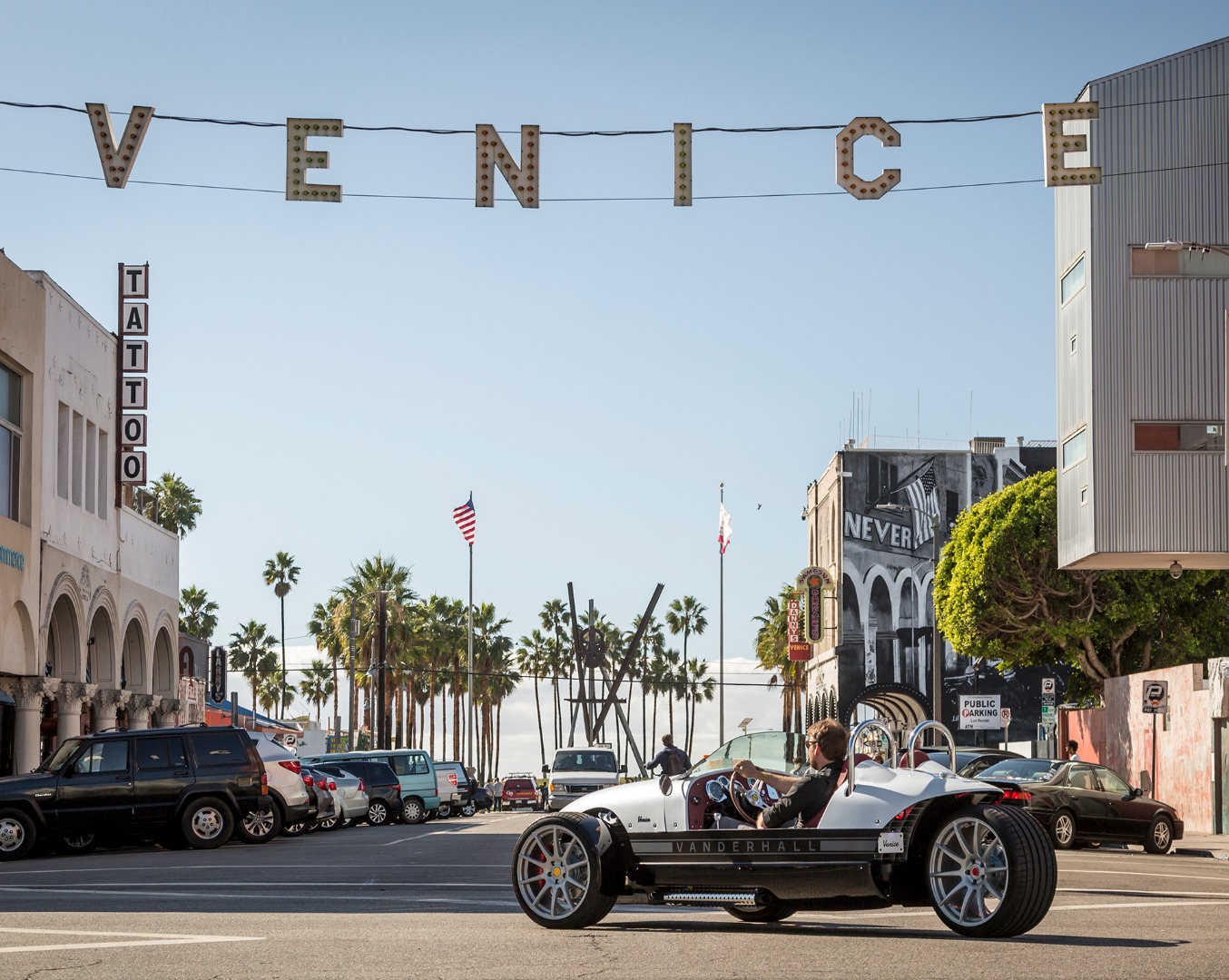
Here are a few ways the Venice may surprise you:
1. Old school is cool.
The Vanderhall Venice has a distinctly retro vibe. Between the wooden steering wheel, the toggle switches on the dash and the lack of digital displays, people could easily wonder if this is your badass grandpa's ride. It's actually a refreshingly simple proposition: In a world where everyone is hurrying to out-tech each other, this throwback three-wheeler is not a silly toy; it just wants you to enjoy the drive.

2. Weird engine noises are awesome.
Under the hood of the Vanderhall Venice is the GM 1.4L Turbocharged I-4 Ecotec LUV — the same engine as the Chevy Cruze. Of course, you’ve probably never heard anyone say, “Listen to that Chevy Cruze!” But in the Venice, between the open top and its minimal shell, the engine sounds are front and center. Don’t expect the sexy interplay of a sports car or the guttural roar of a muscle car; this three-wheeler’s got its own bizarre symphony of turbo whiz and buzzing intake that is wonderfully odd. Once you discover that its 180 hp and 195 lb-ft of torque can get you from 0 to 60 in 4.5 seconds thanks to the wild power to weight ratio, it'll be music to your ears.
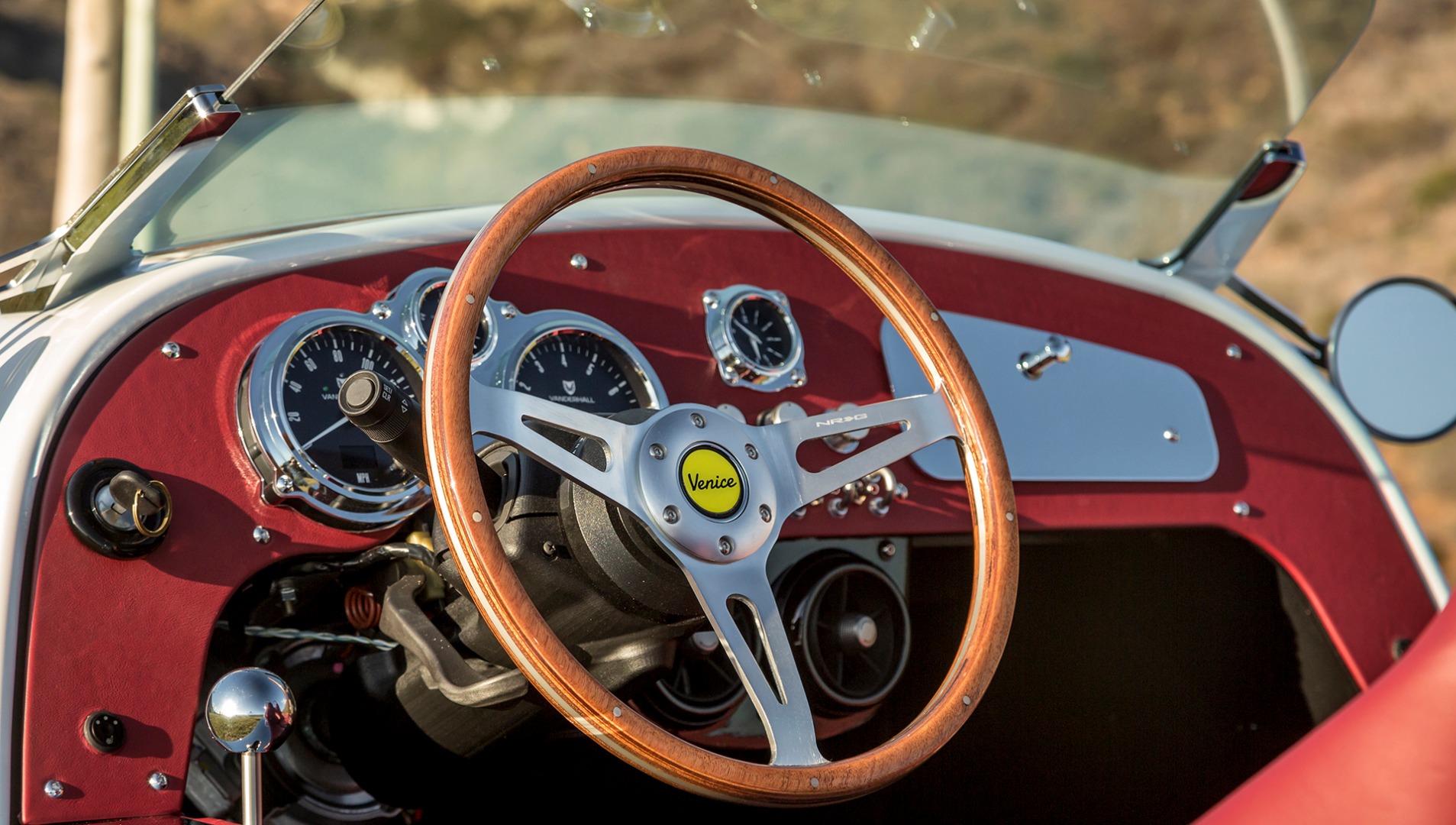
3. Sequential gears can be satisfying.
There’s nothing more annoying than being a manual enthusiast and having someone tell you that the Tiptronic/Geartronic/Sportronic or whatever manumatic is “just as good” as driving a stick. That’s not really possible or even the point. There are, however, automatics that can be truly enjoyable, while others just make you wonder, why bother? The Venice has a clutchless sequential manual mode that is a blast, and its stick's wacky left-side placement just enhances the experience.

4. Conversations are underrated.
Given its simple, old-school vibe, the Venice doesn’t lend itself well to blasting your BFF’s playlist (though you can through its Bluetooth sound system). You’re much more likely to just enjoy the aforementioned engine sounds or to even try speaking words to your co-pilot. Sometimes they may say words back. It’s called “talking,” and it can be great. Try it sometime... you may even end up liking it.
5. Fans feel good.
If you drive a three-wheel open air vehicle that very few have ever seen before, people tend to wave at you... a lot. From bikers to old ladies walking their dogs, to guys driving big trucks and guys driving exotics, people are fascinated. The thing is, there's nowhere to hide in this thing. There's no possibility of blending in, no way to ignore the attention — the Venice leaves you fully exposed. This is really only a problem if you want to pick your nose or be unfriendly. The fact is, the Vanderhall Venice is a vehicle that just makes people smile, and if that doesn’t make you feel warm and fuzzy, you should probably drive a hearse.
Aaron Kaufman's Road to Restoration
If you’re a gearhead, chances are the line “a friend sent me a Craigslist ad” sparks more than a couple stories in your mind. This particular ad had Aaron Kaufman jumping on a plane to NorCal to purchase a sight unseen 1975 F-350 service truck. Most sane people would ship a car home which had sat for an unknown number of years, or at least spend a few days getting it up to speed before driving it 2,200 miles home to Texas. But I’m sure you already know that’s not what Aaron, along with his partner-in-crime Jonathan Mansour, did. Itching for an adventure and with just five days to get it home, these two showed up, “with our backpacks — no tools, no nothing — just vision and stupidity,” as Aaron put it.

The two have been working on launching a new business venture, Arclight Fabrication, after Aaron’s recent exit from Fast N’ Loud’s Gas Monkey Garage. Having a long history with and affinity for old Ford trucks, Arclight Fab will specialize in building aftermarket support for ’57 to ‘79 F-100s. The stars aligned for them in this ’75 F-350 as it makes the perfect canvas for an Arclight shop truck.

The Adventure Starts Before It Begins
Their adventure started before even leaving Texas. Standby plane tickets had them jockeying flights, figuring out how to get to California by morning. They ended up on a late night skip to San Francisco where they hopped in a rental car and jetted north toward Oroville where the truck was.

“We get up to this dude's house, and the truck looks how it’s supposed to look," Aaron recounted. "It does run, it’s got some rough spots, but all-in-all it’s generally as described.” $3,700 and 20 minutes later, they were driving away in it.

“We knew it had no rear brakes, we knew the carb was falling," he said. "The rest we’d figure out.” They weren’t completely crazy, though; they weren’t planning to head to Texas just yet. Seventy-five miles sat between them and a shop that Nor Cal Rock Racing’s John Goodby had secured to help out. The plan was to spend a few hours getting the ol’ truck road-going while they awaited a fresh set of Nitto tires to arrive for the ride home.

What should have taken under two hours took more than eight, but eventually the F-350, now dubbed “Charlie Brown,” made it under its own power. A fuel issue had already reared its head, and they couldn't pull a grade. Without a single tool, Aaron considered calling it quits.

“The money was already stacking up," he explained, "and I was thinking how much worse it could get.” Forging ahead and diligently coaxing the truck along to keep it on the road, salvation was finally found in the form of a shop with some tools, extra hands and resources.

Checklist to Road Trip Roadworthiness
Making quick work of repairs to the carburetor, axle, rear brakes, wheel cylinders, fuel system and the normal checklist of consumables like fluids, belts, hoses and radiator cap — it looked like the new tires might not arrive in time.

“I was willing to drive on the old ones; Jonathan was pretty pertinent about waiting for the new ones," Aaron notes. "The old ones were really old, but they had enough tread on them.” Safety was the prime concern for waiting for the Nitto Dura Grappler replacement tires, but Aaron had also chosen them for “getting the largest roll out circumference."

"Besides," he said, "I have a real affinity for really big tires.” Unable to confirm if their brakes would fit behind new 16-inch steel wheels replacing the old 16.5-inch ones, they were hoping the clean sidewall of the Dura Grappler would fit under the fender as well.

In the nick of time, the new tires arrived and fit under the car perfectly. Just over 24 hours from the time the truck was purchased, the team was “ready” to head off. Next matter of business? Booking miles toward home while stopping off at a National Park they’d always wanted to visit... on a holiday weekend.

“We’re just morons packed into this yellow and brown truck,” Aaron laughed.

A Fool’s Errand?
“This truck hasn’t made it more than a mile unlabored so far," he said. "We have one vehicle, a fraction of the tools needed to do anything with, and we said, ‘Here we come, Yosemite.’” The trek from Folsom to Yosemite is under 200 miles, but that consists of plenty of elevation changes and twisty, mountainous roads with no cell reception.

They took it slowly and made a few stops along the way for minor fixes — meaning they didn’t pull into the park until about midnight.

“Luckily nothing’s fallen off the truck on the way,” Aaron remembered. Thankful that they weren’t stranded somewhere in the dark, they checked into one of Yosemite’s over-priced hotels.

If you’ve ever arrived at a strange place at night, you know the feeling of waking up to uncovering your surroundings in the morning. Up at the crack of dawn for Day 3 of their journey and wanting to make the most of the limited time in Yosemite, they were surprised by their first sight out the window.
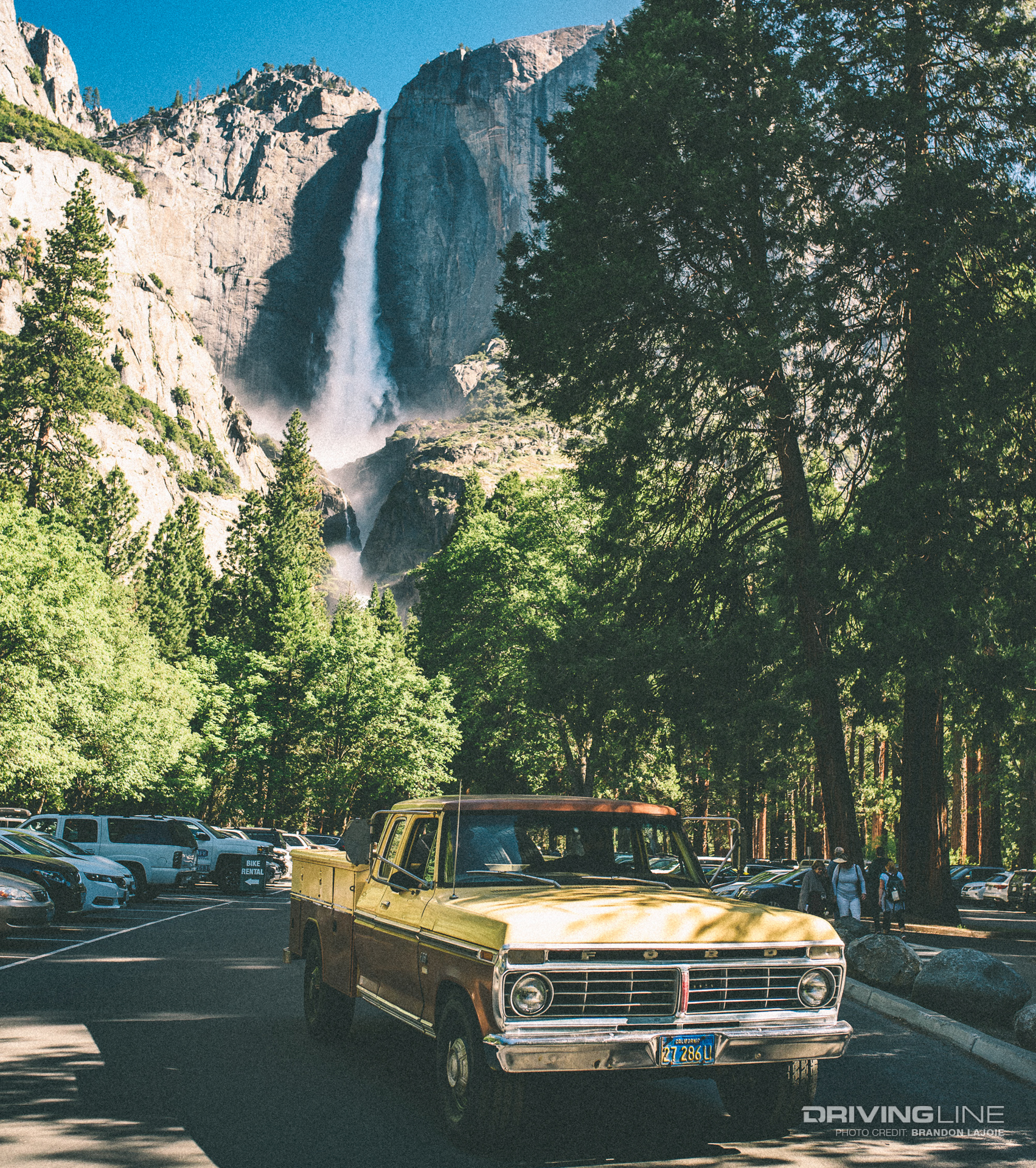
“That noise that I thought was an air conditioner was Upper Falls,” Aaron said. “By 11 a.m. the park was packed to the gills.”

After seeing El Capitan and doing a little early hiking, the crew waved farewell to Yosemite and was ready to book it on home. With a route that would take them 26 hours (according to Google), these guys didn't have much time to spare in order to make it home in their two-and-a-half days of remaining time. Being late would mean missing flights booked and meetings scheduled.

“We stopped in Fresno and made a few little repairs and then hopped on the highway to Bakersfield where we were sidelined again," Aaron said. "I had some minor problems condensing into major ones.” With pressure to get home and a still incomplete toolbox, many solutions had to be MacGyvered. Anyone who has had to get somewhere in a classic car knows the feeling. One problem they were having was their belts. Of course, they’d changed all those back in Folsom.

“Since the pulleys were so rusty, as the load and temperature kept coming up, we kept having to re-tighten and re-tighten the belts... So I got a wire brush and sandpaper, fired the motor up and used it as its own lathe. That way I cleaned up the pulleys, then put new belts on it again to ensure they would bite," Aaron remembered.

“I start to regard this tour as a ‘Road to Restoration’ — it’s really what it is.” With some issues being fixed, they were uncertain if any major ones would strand them roadside in the middle of nowhere. Still, they pushed onward.

“We weren’t so confident in the truck that we wanted to get into LA traffic," Aaron said, "so we went over the hill to the desert and avoided it altogether.” Their day ended in the dark once more, with the crew pulling into Blythe and catching a few winks sleeping in the back of the truck.
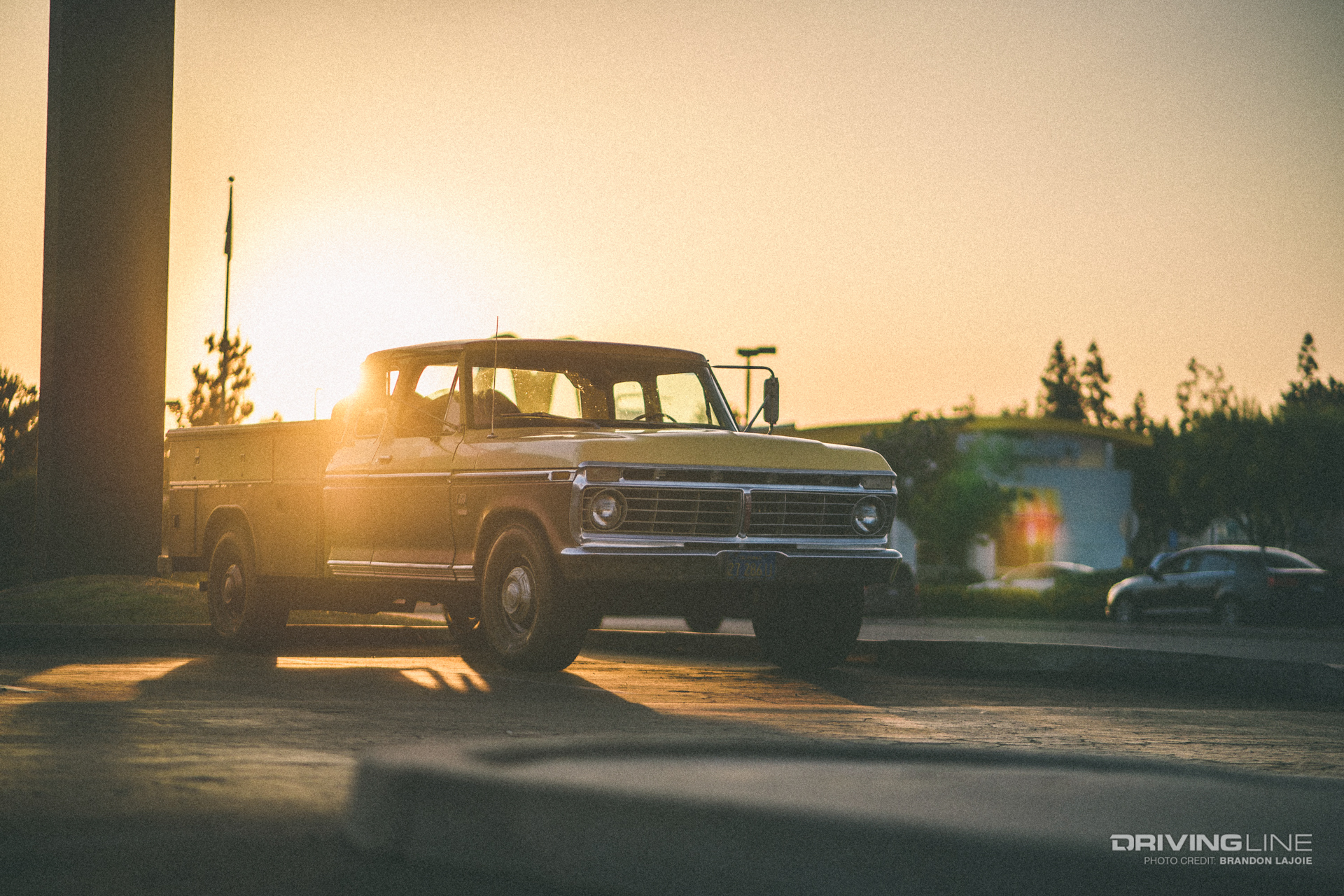
Back on the road at the crack of dawn again, they made it to Chandler, Arizona, just in time for breakfast with local firefighters — a pit stop arranged by a C-10 buddy of Aaron’s living in the area. When you’re given the keys to a firetruck and shown how to run the ladder up 93 feet, even if you’re in a hurry, you stop.

Band Aids and Finding the Right Parts
Not taking too long, half of their 2,000+ miles were still in front of them.

“In Safford, Arizona, our fuel delivery had deteriorated,” Aaron said. “The fuel line routing was such that we were getting some vapor locking issues, plus the mechanical pump was in sad shape. I had band-aided it with an electrical ticker pump, and I think that — combined with ambient road temperature and this relentless 'go-go-go' — we were starting to find the edge of it and have problems maintaining operating speeds from Globe on down into Safford.”

Lacking cell phone service again, they were sure they’d be hitchhiking. Nevertheless, they were able to limp the truck into the next town, where for a second time the local parts store didn’t have the fuel pump they were asking for.

“There’s no way two states don’t have a fuel pump for a big block Ford," Aaron said. "I knew we were asking for the wrong pump.” Finding the correct pump by looking up the part for a car rather than a truck, they hoped this fix would get them across the big state of Texas and home to Dallas.

“Some of these stretches, we were pulling an eight percent grade for miles, and it never really got hot. The AC even worked intermittently,” Aaron said, surprised. Another late night into Van Horn, Texas, and the next day they were pulling into Dallas with a mere 11 hours before catching a flight to Detroit.

Home, Safe and Sound
Sounding almost disappointed that they “didn’t get chased through the desert by cannibal zombies or have to jump a river or anything,” Aaron was eager to say he wouldn’t think twice about doing it over again. “I wasn’t home a week, and someone sends me a crew cab bumpside from Oregon... so another possibility is doing the same damn trip again," he said.

“Ultimately it turns itself into a road to restoration. The truck hadn’t been on the road in years, and it made a 2,200-mile trip — with a lot of coaxing — and now I’m running errands around town in it, and it’s running fine.”

One Last Surprise
As the movie credits rolled on this epic adventure, one last surprise popped up when Aaron returned home from Detroit.
“One of the original tires, which had been sitting in the back of the truck for the ride home, was literally blown apart,” Aaron exclaimed. “It blew up just sitting in the back of the truck. It certainly would have blown up on us if we had run it.” The old tires had conspired against them all along. With so many things that could have gone wrong, and didn’t, it’s almost like they bamboozled fate. “Of course safety is a concern, but we would have damaged the exterior of the truck if that would’ve happened.”

Old tire blowout avoided, and with no major driveline issues, the crew successfully piloted the Charlie Brown F-350 home to Texas. “We got to slow down, stop and spend time in these little towns that we never would have looked twice at, because we were forced to.”

The cartoon Charlie Brown once said, “In the book of life, the answers aren’t in the back.” You can’t fast-forward a good story; you’ve got to journey through it. While many would see car problems as a delay, in this instance it was an excuse to slow down and experience.

“For us, it was going to these great American destinations," Aaron said. "We got to go very Chevy Chase-style — a 2,200-mile trip with the windows down — smell it all, take it in and truly experience it.” Continuing with a token of advice for others, “If you ever want a car restored, but are afraid of the time it’ll take you, drive it across country.”
 All photos by Brandon LaJoie.
All photos by Brandon LaJoie.
Vehicle Specs
| OWNER | Aaron Kaufman |
| YEAR/MAKE/MODEL | 1975 Ford F-350 Ranger XLT Trailer Special |
| ENGINE | Ford 460 V8 |
| TRANSMISSION | Ford C6 |
| EXTERIOR | Original paint, Reading service box |
| WHEELS | Steel wheels |
| TIRES | Nitto Dura Grappler 285/75/16 tires |
Check back soon for more on Aaron’s new Arclight Fabrication venture and what’s next for this old F-350.
New England's Finest at Boston Cars & Coffee
Boston: a city synonymous with our founding fathers, tea party, world class education and world champion sports teams. Its weather and rough roads don’t make it an ideal place for car enthusiasts, but they do exist in New England. After all, not everyone in the region has to drive a Volvo wagon, Saab or Subaru.

Even though it rained the night before, New England’s diehard car enthusiasts came out in full force in Brookhaven, Massachusetts, for the monthly Cars & Coffee on the lawn.

Unlike most Cars & Coffee events which take place in parking lots, Boston's Cars & Coffee is held at the Larz Anderson Auto Museum where cars park on the lawn, creating a great backdrop and giving the event a Concours-like feel.

New England brought out an eclectic mix of British oddities such as a Jensen Interceptor, Morgan 3 Wheeler and Land Rover Defender Series I.

There were three generations of turbo 911s in attendance, from the 930 Turbo (aka “The Widowmaker”) to a 964 Turbo similar to the one Will Smith and Martin Lawrence drove in "Bad Boys."
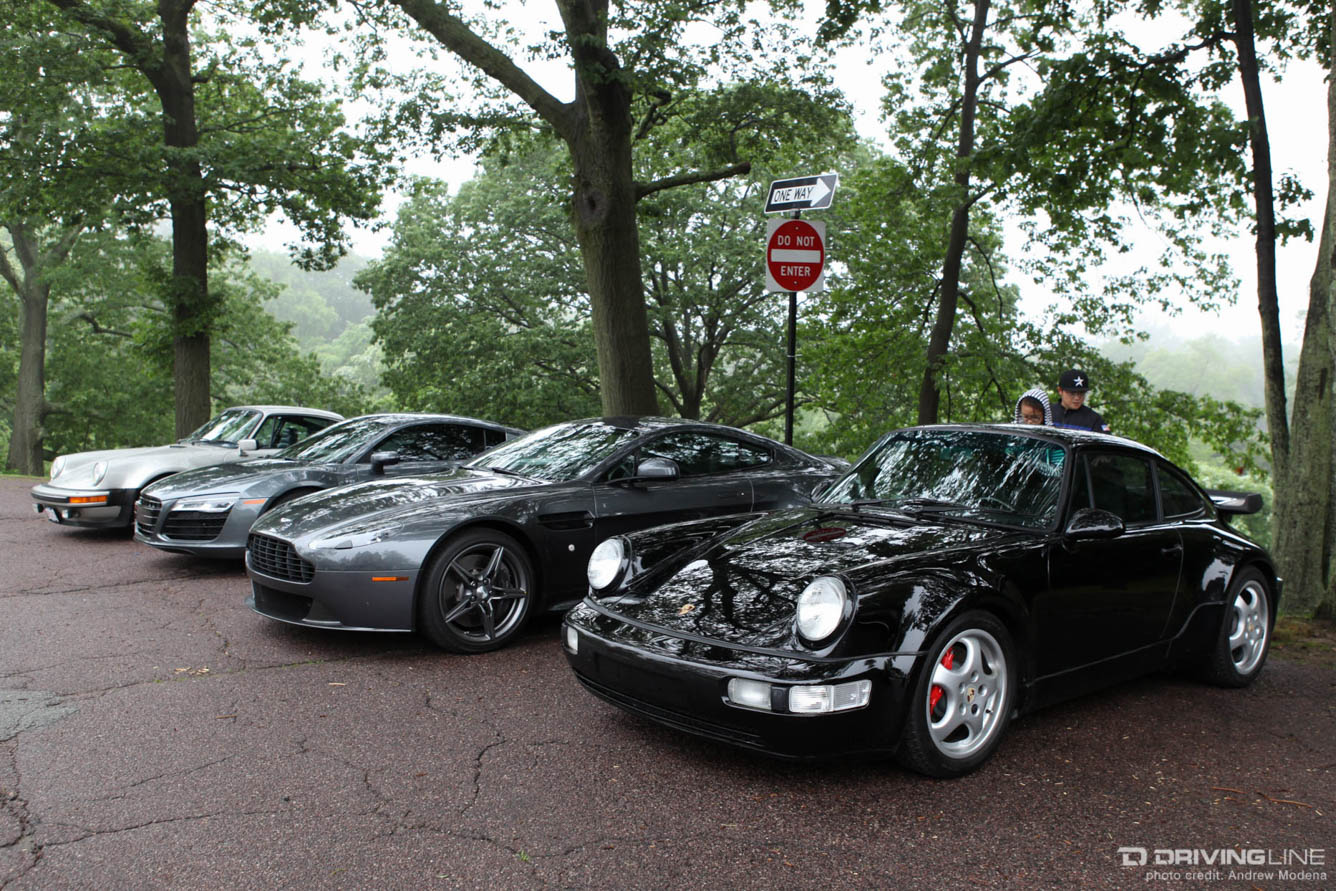
There was also a rare and raw 997 GT2RS; it takes a brave soul to drive a rear-wheel-drive turbo 911 out in the wet.

For the new-school fans, Lexus was on hand with the beautiful new LC500 and a pre-production LS500.


True to any Cars & Coffee, walking through all of the vehicles is like taking a stroll through an automotive time capsule. It's a great way to compare styling trends throughout the generations, like these body lines pure to the '80s.

The Nissan Skyline and the Toyota Supra are some of the '90s' and '00s' finest.

The current generation of Porsches and BMWs are the perfect combination of traditional styles updated with new technology to serve as modern day dream cars.

Not often will you see an F-150 Lightning parked next to a JDM Nissan Figaro.

At most Cars & Coffee events, there are plenty of American muscle cars; in Boston, there were a lot of classic American cruisers, like this '58 Lincoln Continental Mark III.

This rare Vixen 21TD RV (one of less than 600) is how families used to go on road trips in style.

If you’re in the New England area, make sure to stop by and check out one of the most unique Cars & Coffee events, every second Saturday morning of the month at the Larz Anderson Auto Museum.
See more from Boston Cars & Coffee in the photo gallery below.
10 Common 4x4 Builder Mistakes (and How to Avoid Them)
The biggest difference between a mall crawler and dedicated off-road rig isn’t in how it looks, but more typically, how it’s built. It’s all in the details. Understanding the difference between a “lift kit” and performance suspension system, outfitting your rig with proper traction aids and picking the right tire for the job are all part of the builder equation. While style can be subjective, there are definitely right and wrong ways to build a trail-worthy 4x4.

To better help keep your build on track, we’ve put together a list of the 10 most common builder mistakes and how to avoid them.
1. Big Tires, Little Axles

An aggressive set of oversized treads is a great way to help your 4x4 get farther down the trail. The added ground clearance, along with a larger footprint, can do wonders in the dirt. But don’t over-tire your drivetrain. There isn’t a steadfast rule for this as there are dozens of factors to consider (vehicle, suspension and axle type being among some of the most important).
Research is your friend. Just because you can run a 40-inch-tall tire, doesn’t mean your axle can handle the added mass. You’ll have more fun and go farther on a smaller and more aggressive tire over one that’s simply too much for your drivetrain to handle.
2. Differential Gearing

Now that you’ve decided on a more fitting tire set, you’ll want to invest in a numerically higher differential gear ratio. Sure, your truck might feel OK with the larger treads and stock gearing, but you’re only adding stress to the transmission and missing out on performance. Moving to a higher numerical gearset will ease the strain on your powertrain and get your rig working better on-road and off. Factors such as a manual or automatic transmission, engine type and tire size are all considerations when determining the best differential gear ratio for your 4x4.
3. Lockers Before Lightbars

We get it. Lightbars are in Vogue. But, they’re not going to be the reason you can drive farther down the trail at night. A set of differential lockers on the other hand will make sure that each tire is fighting for traction. If you can only afford to upgrade one axle at a time, we say go with a rear locker. For those daily driving their 4x4, a selectable locker, such as an ARB Air Locker, would be our first choice.
4. Get a Fire Extinguisher!

We’re amazed at how many rigs don’t have a single fire extinguisher inside. Most organized trail rides require at least one fire extinguisher per vehicle. A basic ABC extinguisher can be picked up from your local home improvement store. We like to carry two — one that’s in reach of the driver and one that’s easily accessible in the back of the vehicle.
5. Wired Up

Now that you have your fire extinguisher onboard, we can talk about one of the most common causes of vehicle fires: poorly routed and connected electrical wires. Spend the time to makes sure you’re properly connecting, routing and sealing your wires. If you’re planning on running a host of accessories that demand a lot from your electrical system, consider running a separate battery. Draining your battery can not only leave you stranded but also damage your vehicle’s expensive onboard computer.
6. Bump Who?

Bumpstops prevent your vehicle’s suspension from compressing beyond its intended design. Running without bumpstops can lead to damage to your rig’s suspension and/or drivetrain. Bumpstops are also a great way to moderate your suspension travel so you can run a larger tire with a low amount of lift. In addition, they can be the critical factor in preventing two components (such as a differential and oil pan) from colliding during up travel.
Most new suspension systems come with bumpstop brackets to work with your existing stops. The challenge many old vehicles encounter is that the OE bumpstops deteriorate over time. Companies such as Daystar and Energy Suspension are both excellent sources from OE replacement bumpstops.
7. The Right Rubber

As the only part that’s actually designed to touch the terra firma with frequency, your 4x4’s tires are critical to its performance on the trail. Since most people daily drive their four-wheel drives, there is often a misconception that you need some sort of all-season tire to retain good highway behavior. This just isn’t the case. With companies now offering more aggressive versions of all-terrains, such as the Nitto Ridge Grappler, you no longer have to sacrifice off-road performance in the name of on-road handling and tire longevity. It’s equally important to make sure you pair your tire with the correct load rating for your vehicle.
8. Suspension: Performance vs. Lift
![]()
There’s a significant difference between a performance suspension system and a basic lift kit. If all you are looking for is a little extra suspension height so you can raise the vehicle and clear a larger tire, then a basic “lift kit” is fine. The main differences between a basic lift and a performance suspension system have a lot to do with vertical wheel travel and the dampening properties of the shocks.
Performance suspension systems (sometimes labeled as long-travel suspensions) are designed to increase your suspension travel, so your tire stays in contact with the ground. Increased wheel travel, when paired with more dynamic shock absorbers, can equate to better vehicle control and ride on-road and off. Yes, most performance suspensions raise the vehicle as well, but that’s not the primary goal.
9. Sway the Right Way

From the factory, your 4x4 is equipped with either one or two sway bars. Most commonly, your rig will have at least one front sway bar. Do yourself a favor and buy a set of sway bar disconnects. Off-road, you want the suspension to cycle freely and by disconnecting the sway bar, it has a better chance of doing so. The goal is to keep your tires in contact with the ground at all times. Not every vehicle make will have a readily available sway bar disconnect. If that’s the case for your rig, simply learn how to remove the sway bar links or bar when you hit the trailhead.
10. Stop It Now!

Don’t overlook one of the most critical areas on your 4x4: the brakes. Adding on larger tires, bumpers and trail gear puts an added strain on your braking system. Big brake kits are not cheap, but they are well worth the money spent. Even a modest investment in a better set of brake pads, such as the ones offered from EBC, can make a noticeable difference.